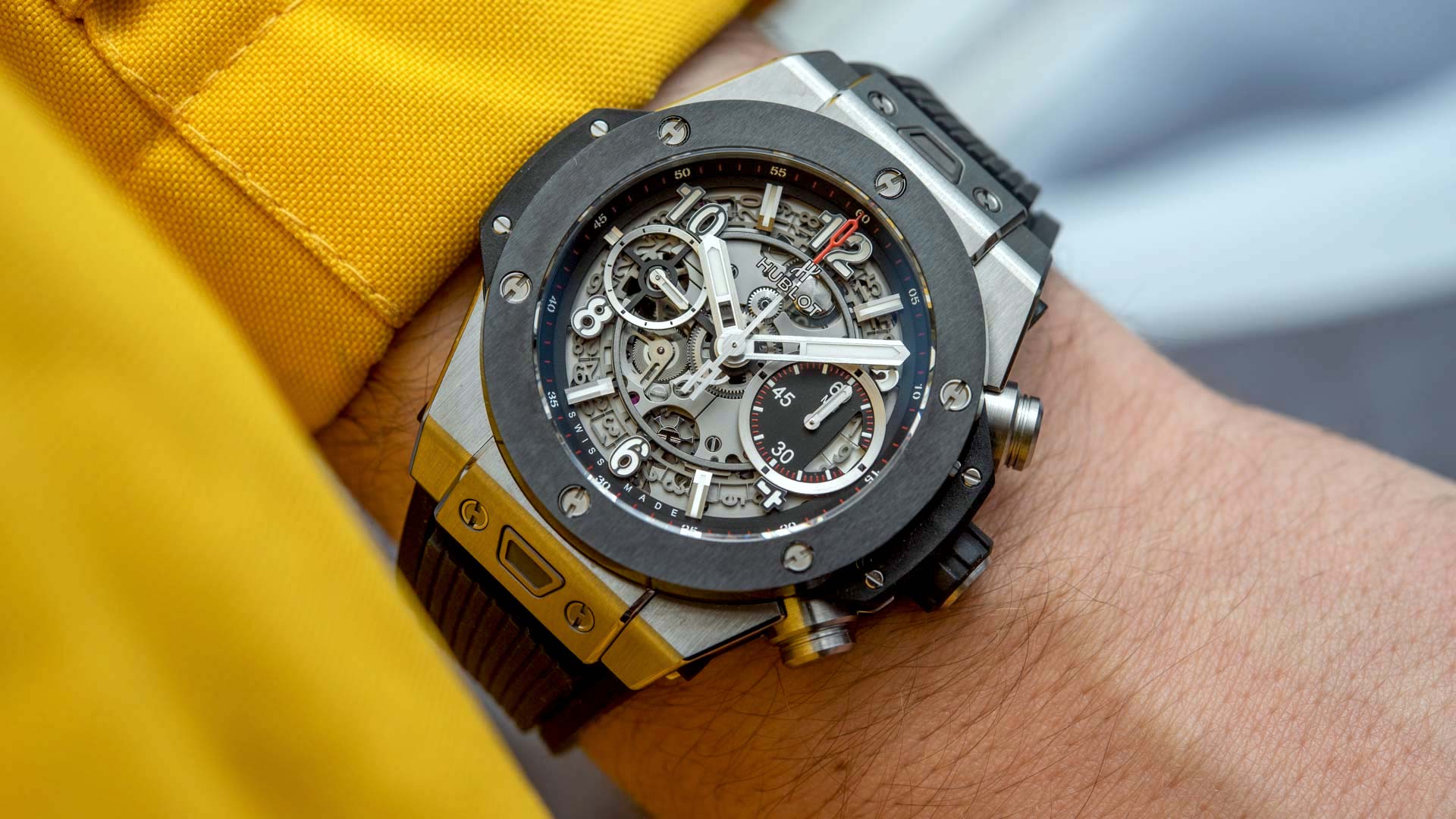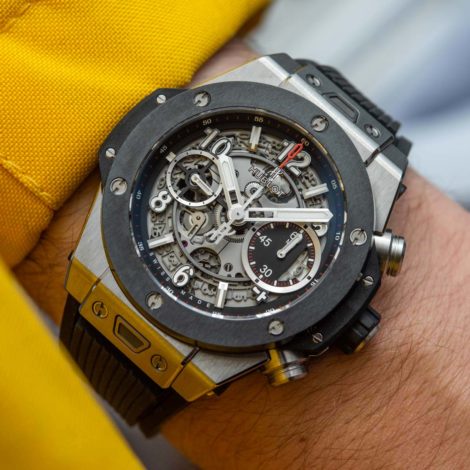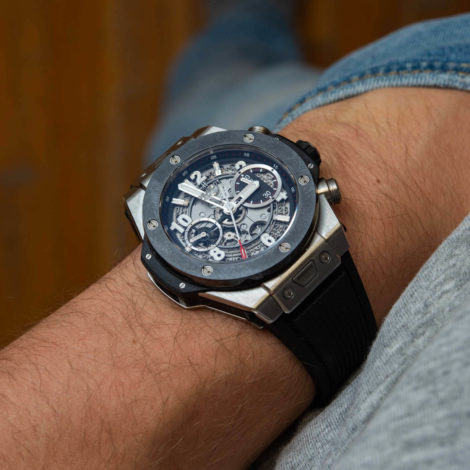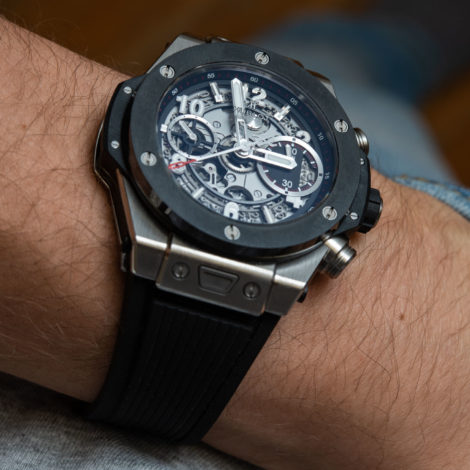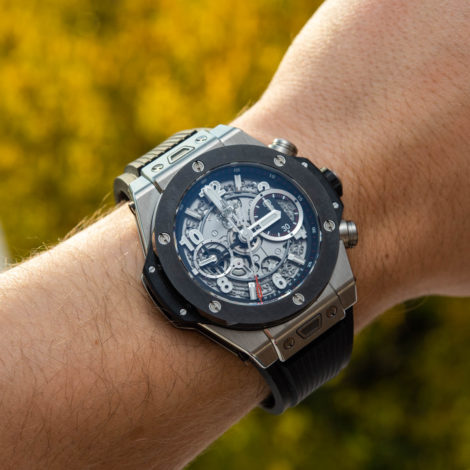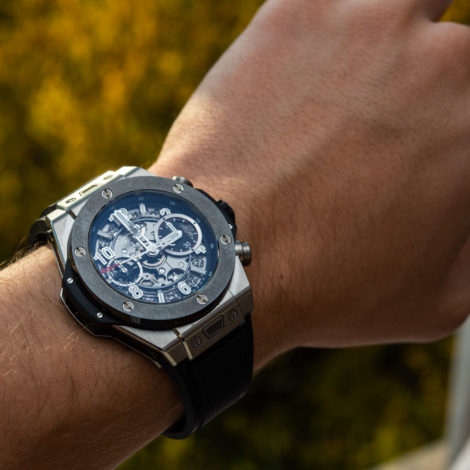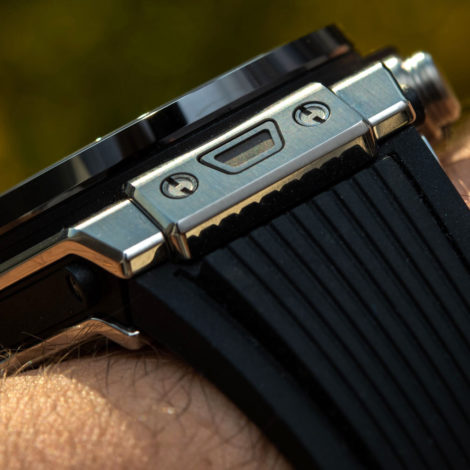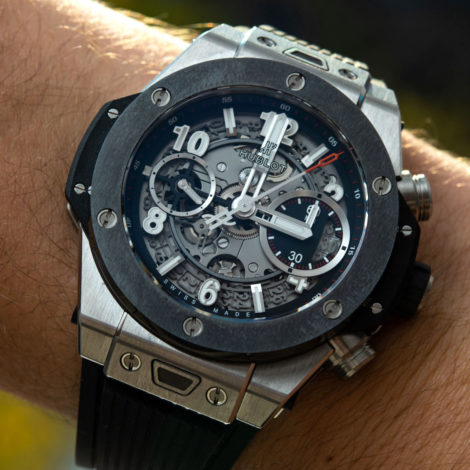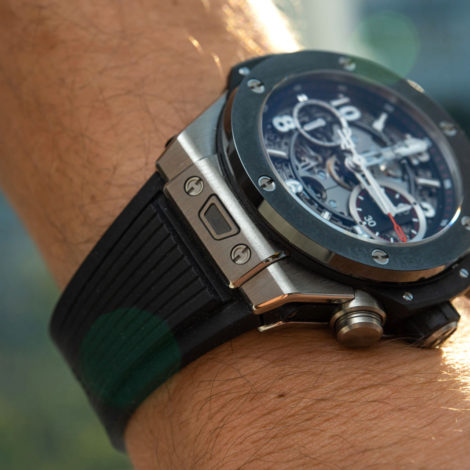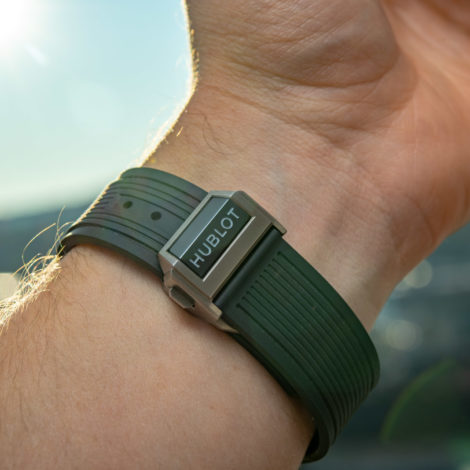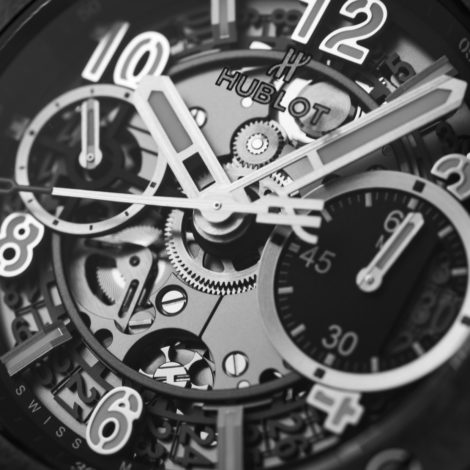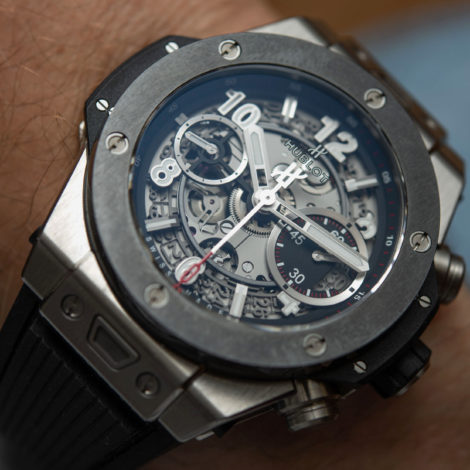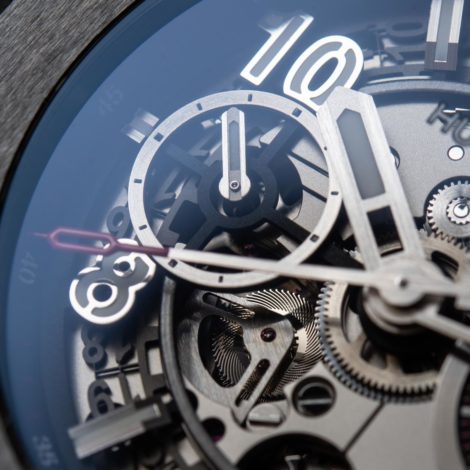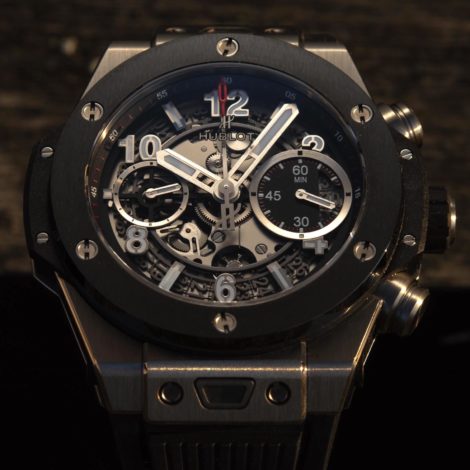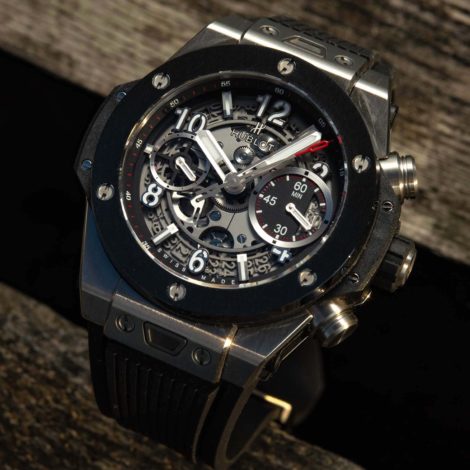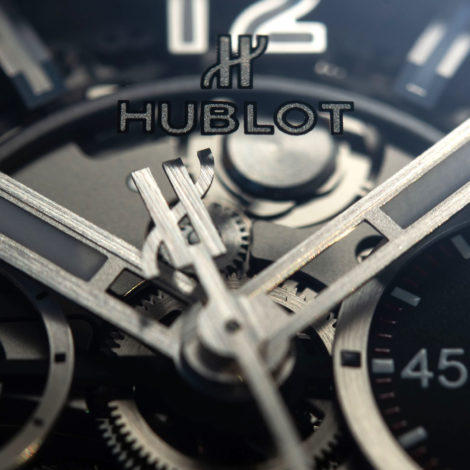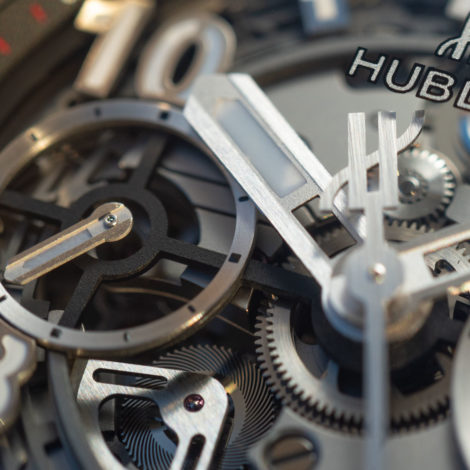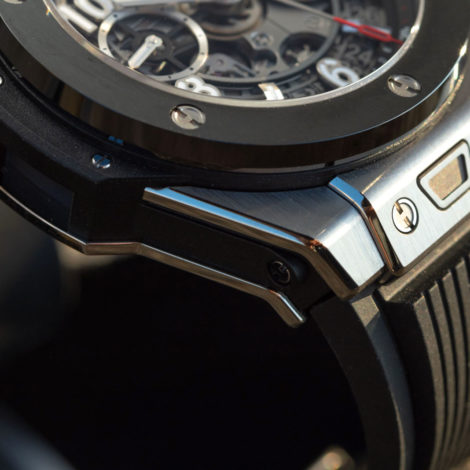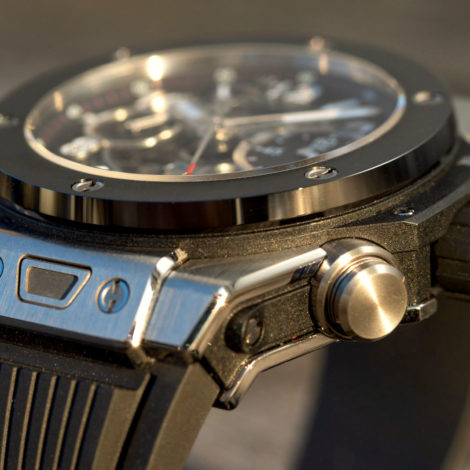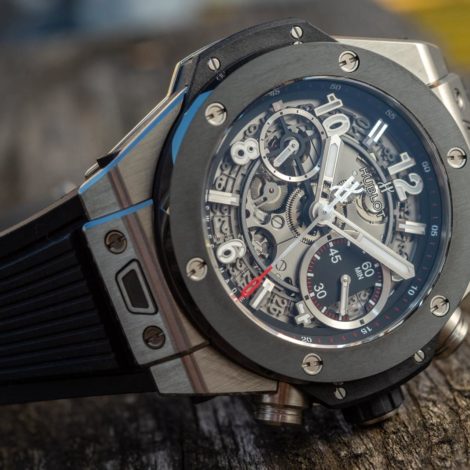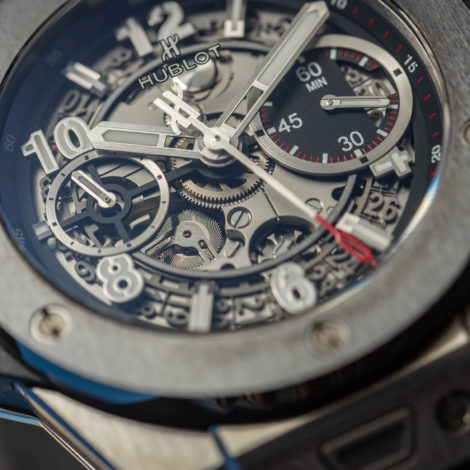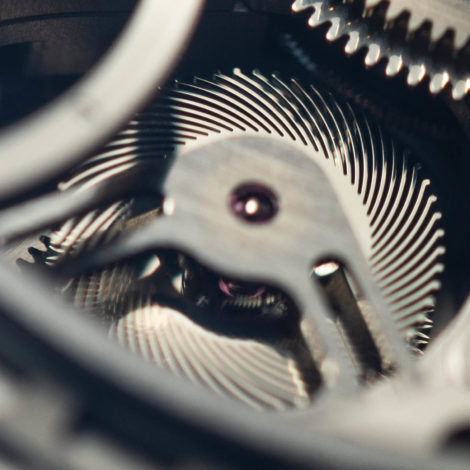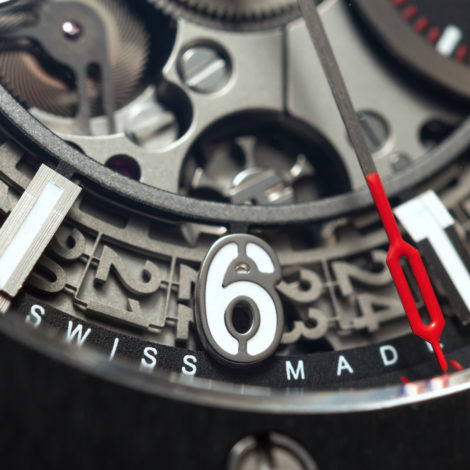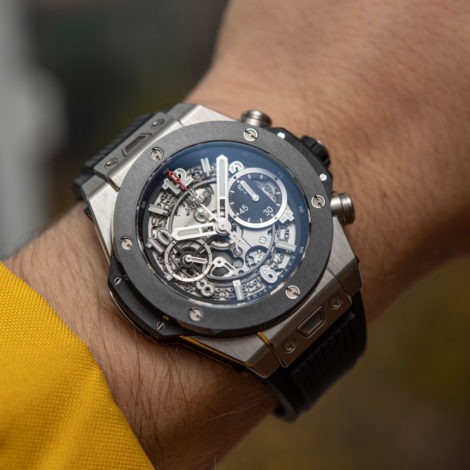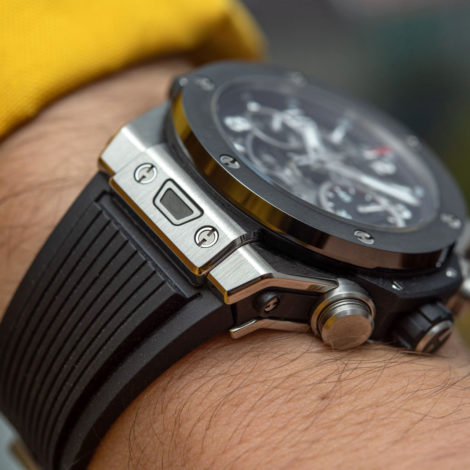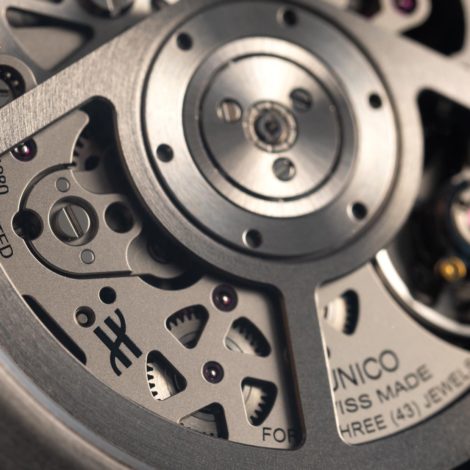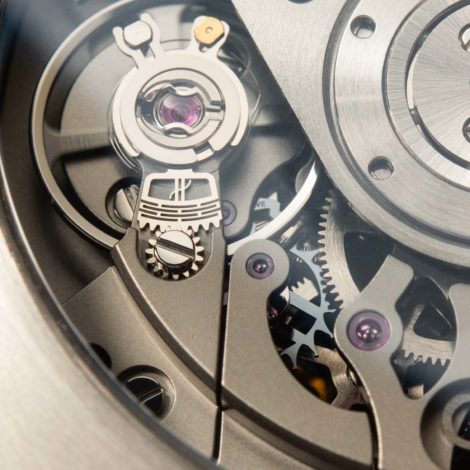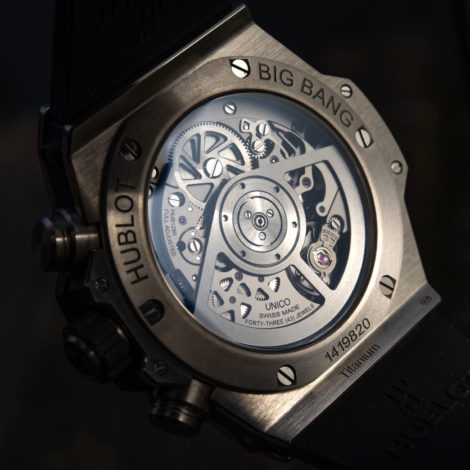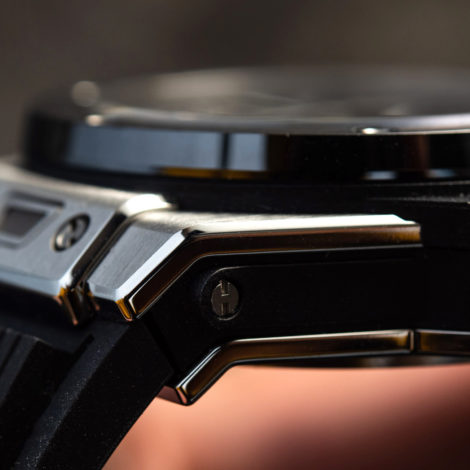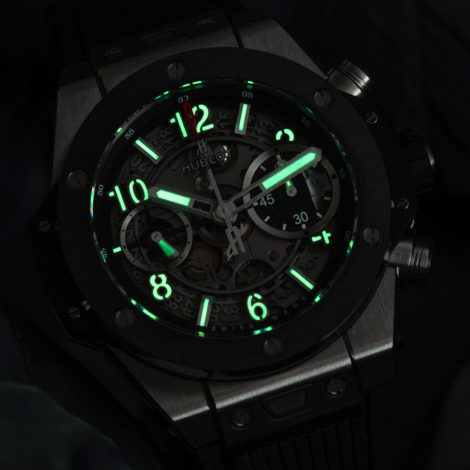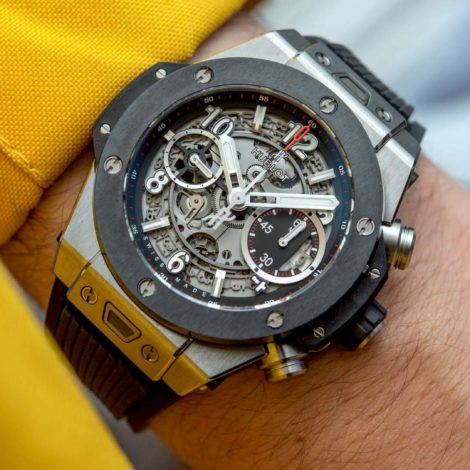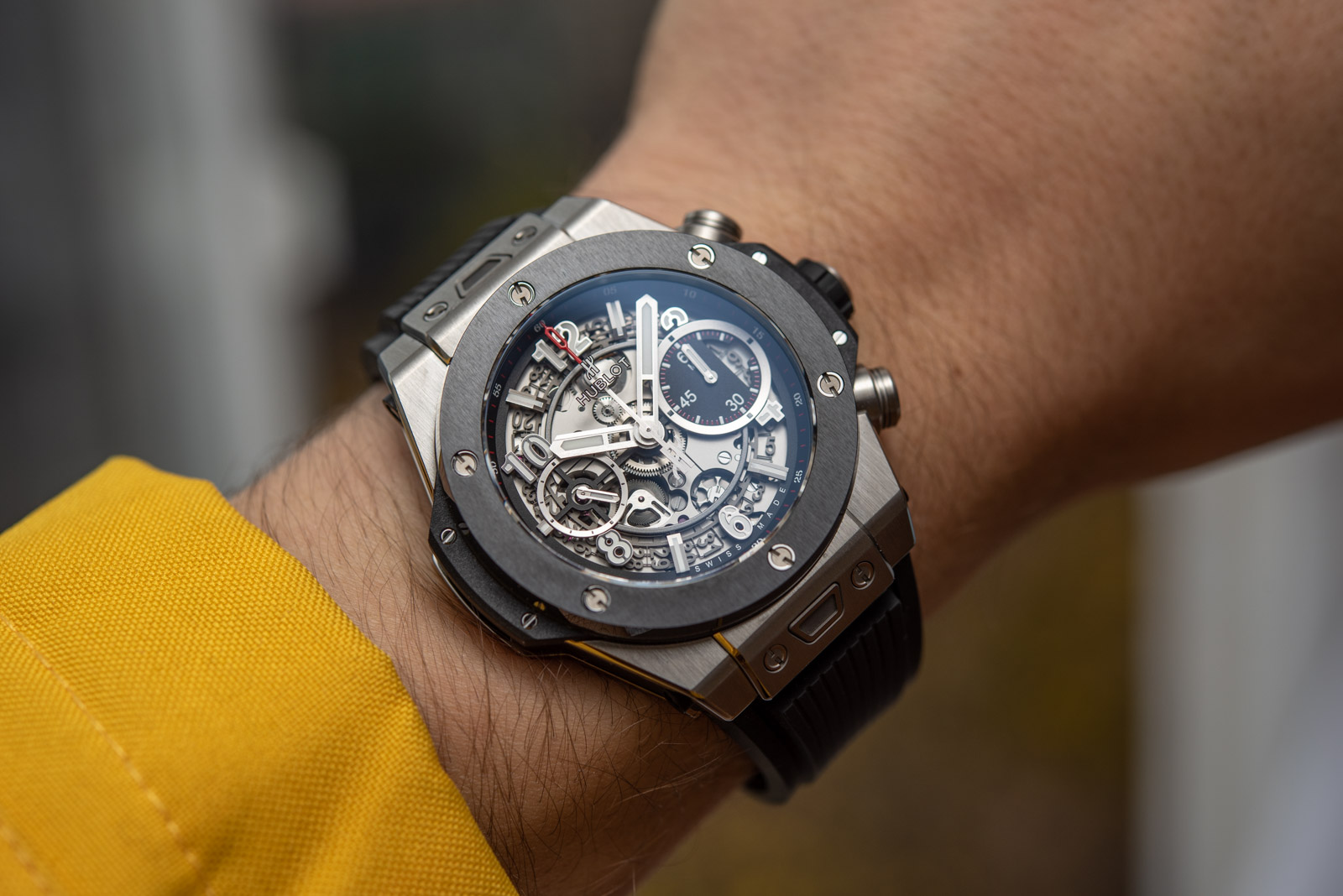
As far as I’m concerned, Hublot occupies two scarcely intersecting dimensions. First, there is the premiership footballers’ and footballer-wives’ Sellita-equipped expensive-looking watch. These have already been perfected to meet the rather straightforward expectations of their target audience. Then, there is the world of Hublot we are looking into today, the Hublot that takes watchmaking and its every aspect very seriously. Behold the Hublot Big Bang Unico Titanium Ceramic 42mm chronograph, a more scaled-back presentation of Hublot’s highly capable in-house chronograph caliber Unico.
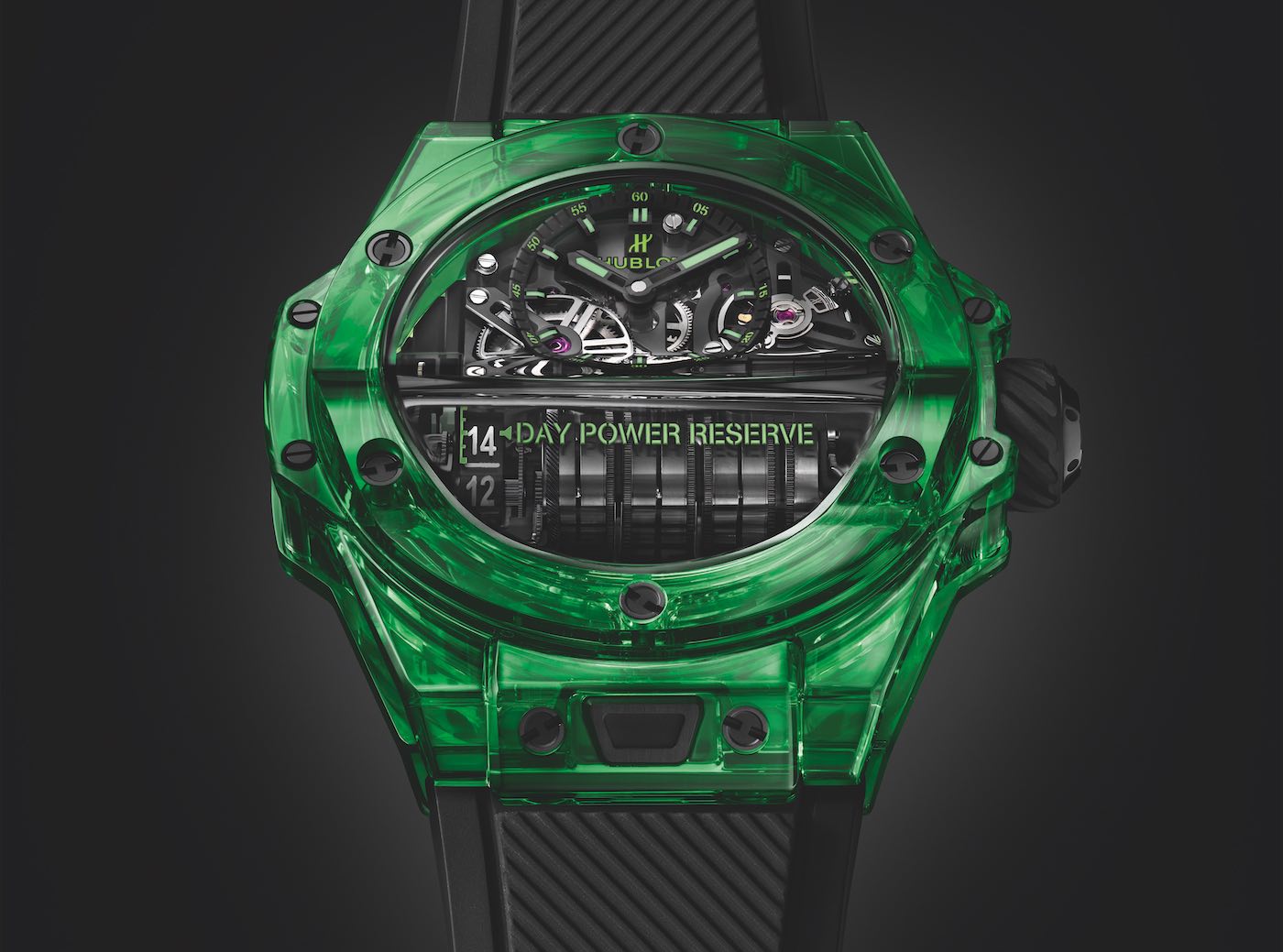
Along with the ultra-high-end range of MP calibers, the Unico (and the MECA-10, for that matter) is Hublot’s ways of telling the world they not only can do modern, bespoke, high-performance movements — but they also love to. And with this, they are already ahead of a number of other, far less controversial but more historic, brands that rarely do as much with their movements as does Hublot. But Hublot doesn’t stop there and works harder at the creative development of cutting-edge materials than any other watch manufacture in its segment. There’s zero contest in that department — to Hublot’s credit and the shame of the rest. Scratchproof 18k Magic gold, vibrant-colored ceramics (and a lot more to come there), all made in-house, are just the tip of the iceberg.
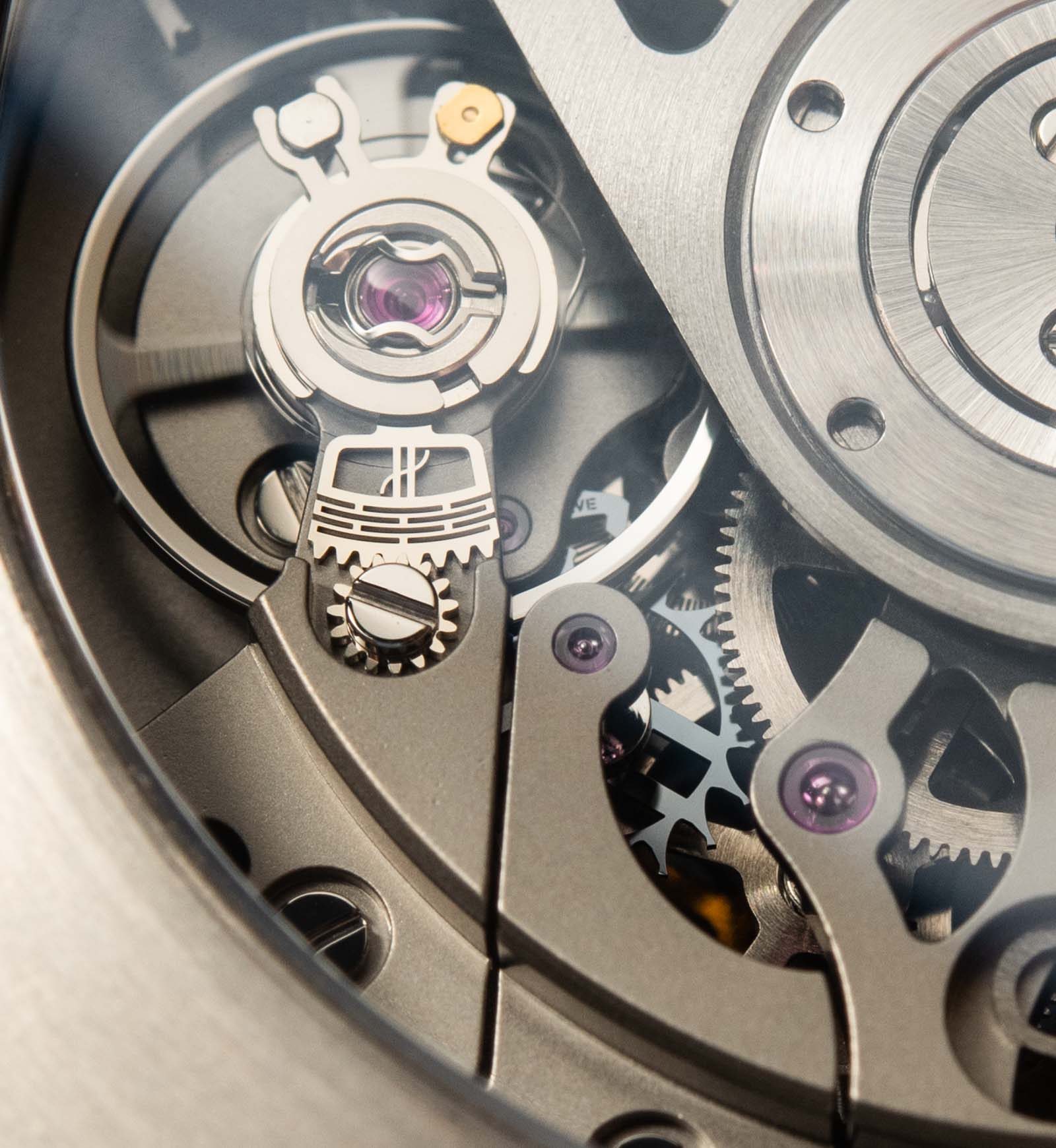
When it comes to hardcore, traditional watch-lovers, Hublot’s struggle, if we can call it that, is that many among us go out of our way to practice our God-given right to be mad about the footballers’ watches and, worse still, have that anger serve as the reason to ignore those other watches that do actually help advance the sort of watchmaking we all like. Materials, craft, and watch movements have all been, in more than one way, advanced big-time by Hublot.
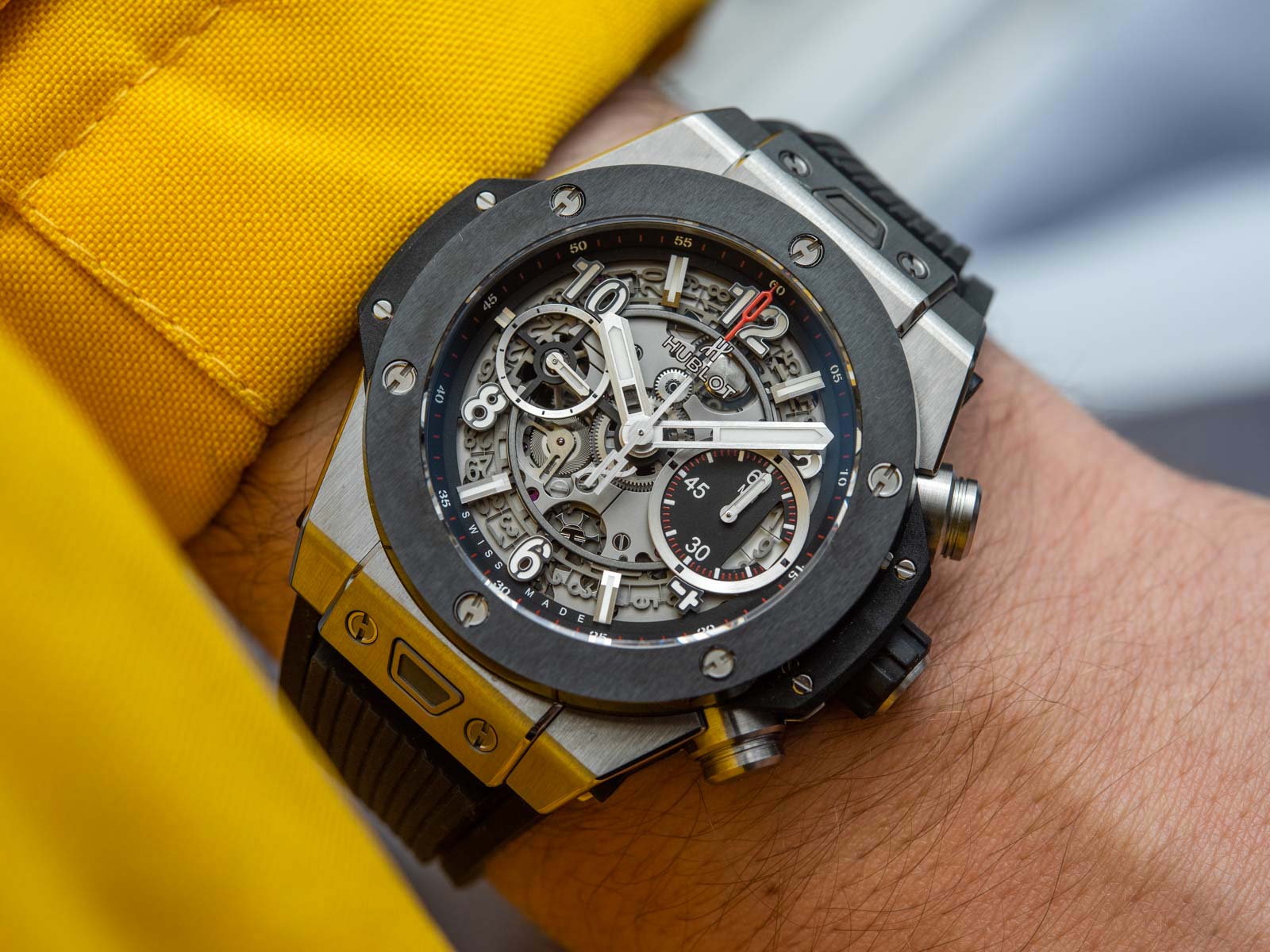
However, missing were designs that were more in tune with the increasingly more restrained times, aesthetically speaking, offering a more compact size and a less-shouty version of… everything. Until recently, every Hublot watch that would tick the right horological boxes — novel materials, cool in-house movements, relatively more wearable aesthetics — was still either too large at 45mm-wide or simply too expensive for what it was. Don’t get me wrong, priced at €18,600, the Hublot Big Bang Unico Titanium Ceramic 42mm is still dearly expensive, but not only is that price close to where it should be when compared with the feature-sets of competing watches, but this smaller Unico also appears to fit all those newfound criteria concerning a relatively more discreet presentation, including a more reasonable case size. And so I decided to review this 3mm smaller presentation of the Unico for those well-heeled watch-lovers who appreciate and enjoy Hublot for its horology-focused dimension but were yet to find a watch compact and wearable enough to serve as their point of entry into Hublot.
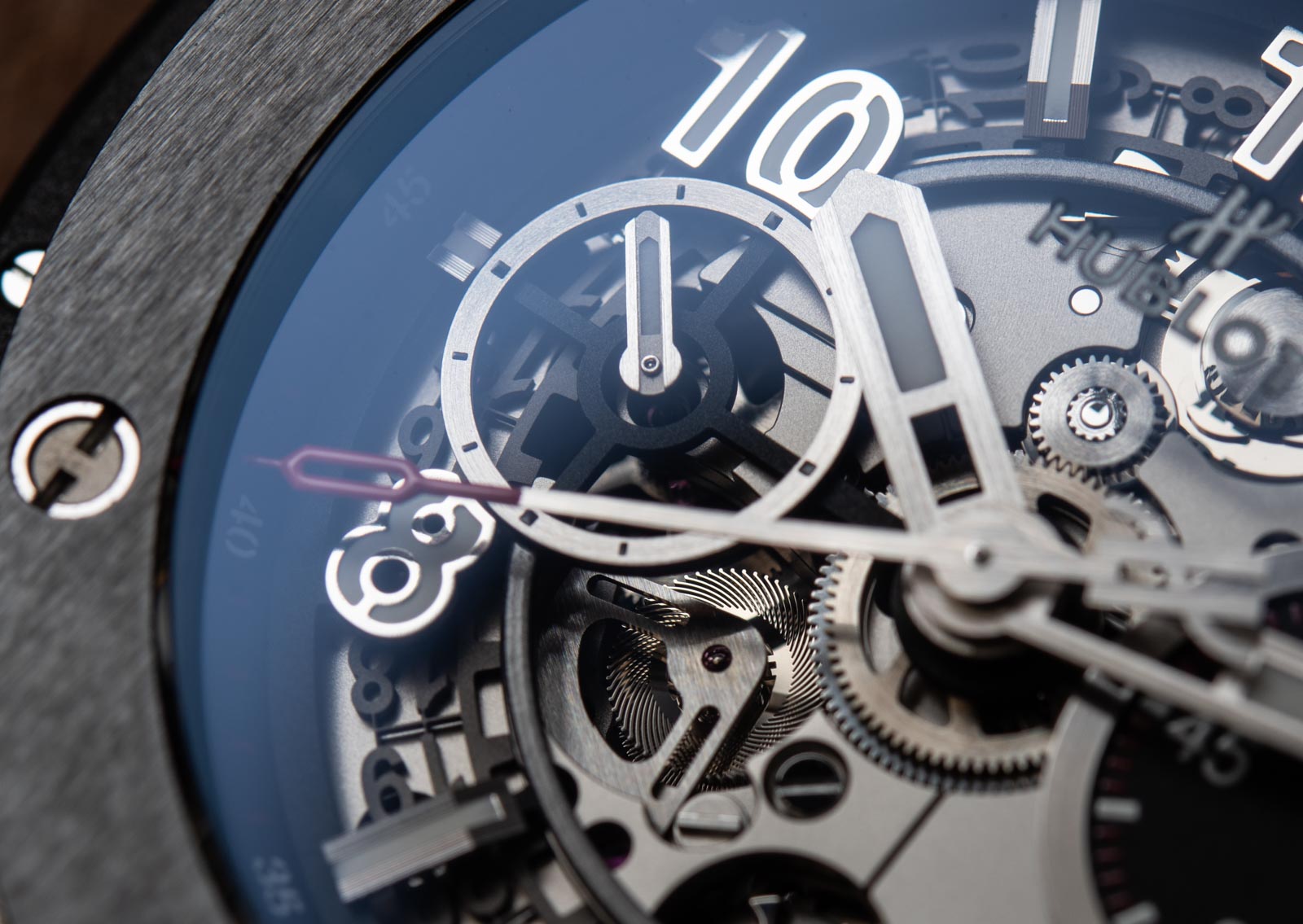
Nerding The Hell Out Over A Hublot Big Bang
The Hublot Big Bang Unico Titanium Ceramic 42mm aptly illustrates that if Hublot wants to kick some horological arse, it need not visit the neighbors for some inspiration. First introduced to the world in 2010, around the peak of the watch industry’s in-house ego trip, Hublot’s Unico caliber was a real tour de force. Here are some cool features you probably didn’t know about the Unico — and, coincidentally, some cool features I don’t recall any other modern chronograph movement having in the same single package.
- It has a modular escapement. To make servicing easier, the escapement module that comprises the balance wheel, escape wheel, and escapement assembly can be removed from the Hublot Unico as a single unit, without having to disassemble more of the movement. This makes servicing faster and easier.
- Its chronograph operates with an entirely reworked oscillating double-clutch. I asked Hublot about this, since absolutely zero information was available online, and I was kindly forwarded to some of the eggheads inside the Nyon manufacture who explained, “This is a revolutionary new clutch system that has allowed us to make the chronograph more reliable and less energy-consuming. A single clutch offers no visibility on its operation, which is why we chose to keep a double-clutch. It has two other advantages over a single clutch; its reliability and an eliminated risk of slipping that would distort timing. On the other hand, the classic double clutch has two disadvantages, namely, the overlapping of the chronograph hand and the starting jump. Hublot’s oscillating double-clutch all but eliminates its disadvantages, so now there is vastly improved visibility on the clutch function; improved reliability; no risk of slipping; no needle overlap; and more strongly attenuated start jump.” This, combined with the column wheel, makes for a remarkably smooth and easy operation of the chronograph start-stop pusher — tactile proof of the refined mechanics at work on the inside.
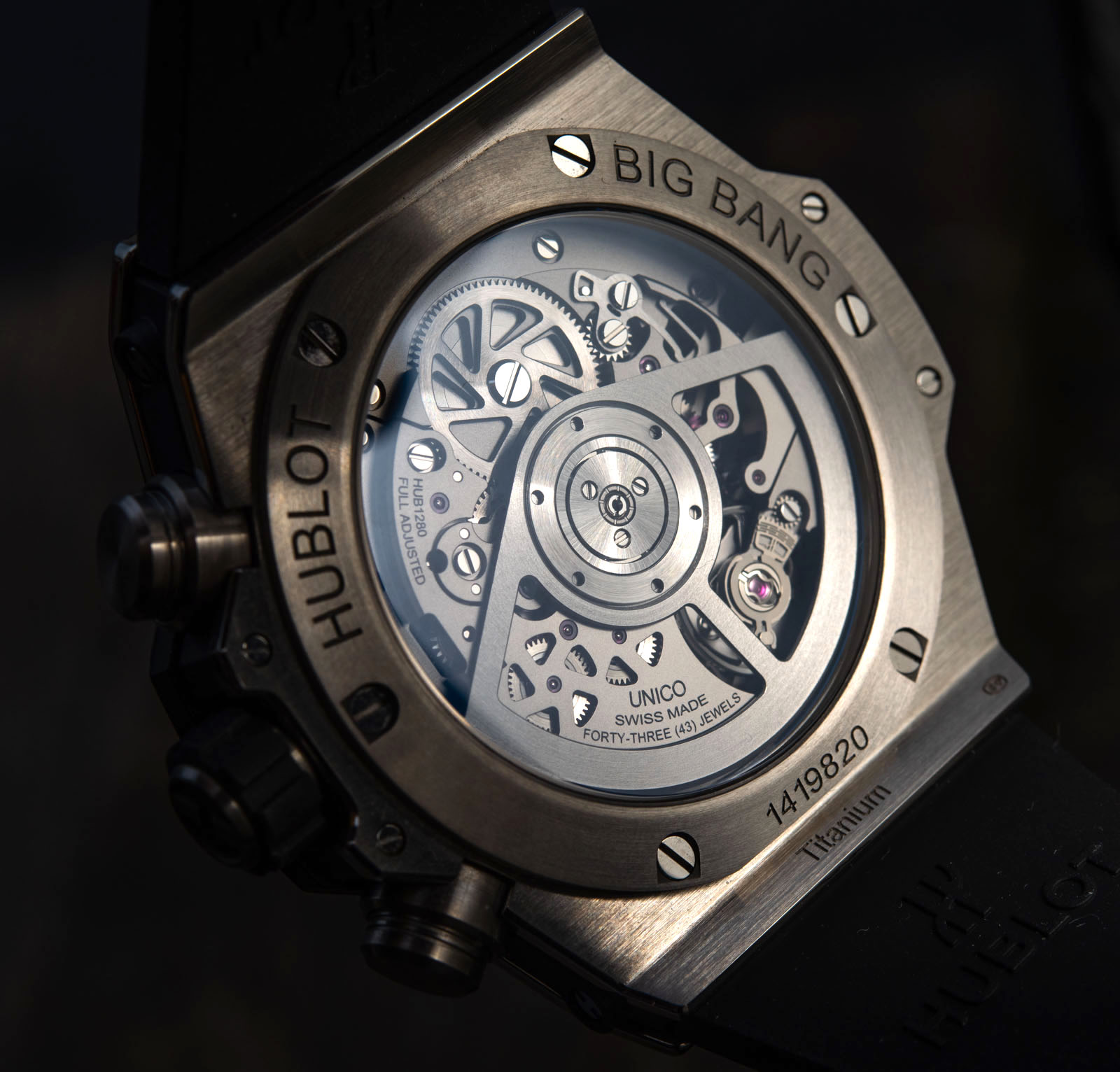
- Hublot has greatly reworked the original HUB1242 Unico caliber (fitted to 45mm-wide versions), re-tailoring it for the 42mm version and renaming it to HUB1280. They left width at 30mm but shaved 1.3mm off its thickness to keep the case’s diameter-to-thickness proportions the same. I asked myself how many other manufactures can I name that do stuff like this? What about you?
- Although it doesn’t look it, the Unico caliber was designed to be (relatively) easy to build upon. A perpetual calendar-equipped version with moonphase indication exists, and the Unico was tough enough to carry the larger and heavier handset of the Sang Bleu and Sang Bleu chronograph models, too. Maybe the modular escapement could give way to a tourbillon version later on — who knows?
- It’s a fly-back chronograph. At the press of the reset button, the running chronograph is stopped, reset to zero and, as you let go of the reset button, is restarted again. All that happens at one press of a button.
- Hublot strategically incorporated automated and semi-automated processes into the manufacturing design of the Unico, including a fully robotized lubrication system that ensures every required component of every Unico movement is aptly lubricated.
And the list of Unico features goes on, reaching Richard Mille depths of intimidating descriptions and technical muscle-flexing. For example, “The thinner HUB1280 abandoned the original’s Pellaton self-winding system for a double reversing switch with ball-bearings.” Show me someone who says he knows what that looks like and I’ll show you a liar. Component count throughout the redesign has increased from 330 to 354 parts, including five extra jewels that increased their count from 38 to 43. And we are still not done.
Well over a year ago, I started following the then-obscure Instagram account of a Japanese watchmaker (@_hiiih_). Focused on Rolex watches, he posted a very high magnification image of a special wheel that lives inside the Rolex Caliber 4130, the movement that powers the Rolex Daytona chronograph. Upon seeing that weird wheel, I sought the assistance of certified Rolex service watchmakers in a few different countries, and not one of them could explain to me exactly what that weird wheel was about. Still, left to our own devices, it’s worth discovering this weird little wheel that neither Rolex nor Hublot talk about — and yet both manufactures assign a very important role to this high-tech wheel. Importantly, Rolex switched to this wheel relatively recently, as the 4130 (in production since 2000) has not had this, just an ordinary-looking small wheel in its place.
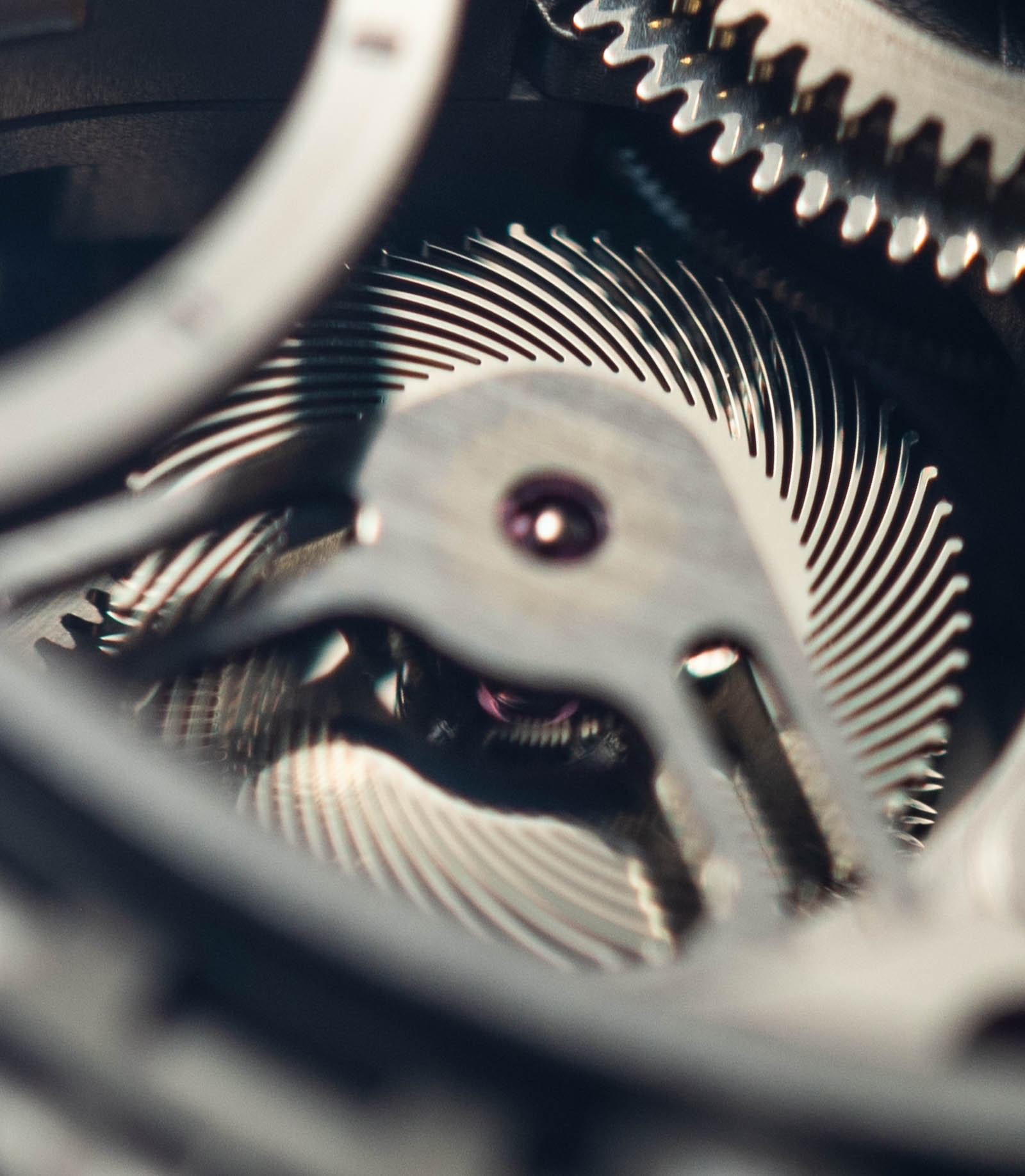
I turned to Hublot HQ again which, unlike Rolex, not only knew but were also willing to share what this was about. Based on its location inside both the Rolex 4130 and the Hublot 1280, it is obvious to any hardcore watch nerd that this gear is assigned into the wheel train of the chronograph mechanism. Both calibers have a base timekeeping unit that works like every other mechanical watch: Energy is transferred from the mainspring barrel through a so-called going train (a series of wheels and pinions) to the escapement that essentially keeps the time. The chronograph mechanism relies on this base movement to feed it with timekeeping information to the dial side where the chronograph mechanism (in these more modern automatic calibers at least) has been relegated to. And so, this weird-looking wheel is part of those wheels that transfer drive to the chronograph module. Further below its functionality is explained — but before you read that, make note of the fact that this weird wheel is rotating constantly, even when the chronograph is stopped.
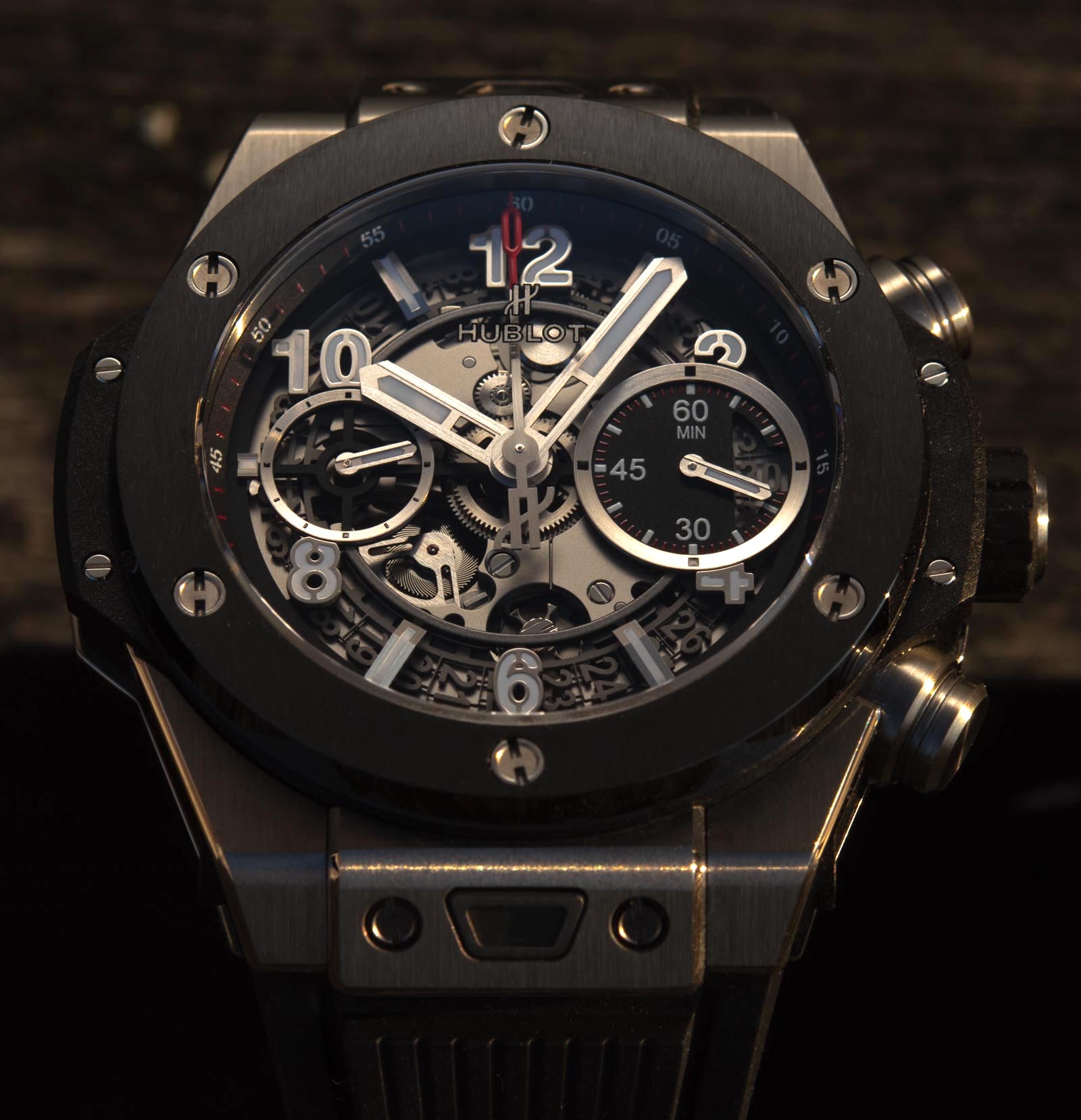
Why the extremely small, extremely complex and, by design, flexible teeth? These teeth make a world of a difference every time the chronograph is started. In the Hublot Unico HUB1280 movement, when the pusher at 2 o’clock is pressed, the chronograph is initiated. This results in the advancement of the column wheel and the lateral movement of cams and levers. Along with those, this weird-looking wheel that Hublot calls a “spring-tooth wheel” makes a lateral movement and gets pressed against the (thus far stationary and ordinary-looking) wheel that sits in the bowels of the movement, under the very center of the dial and its central chronograph seconds hand. When the connection between the flexible teeth and the ordinary wheel is established, the chronograph seconds hand starts to move.
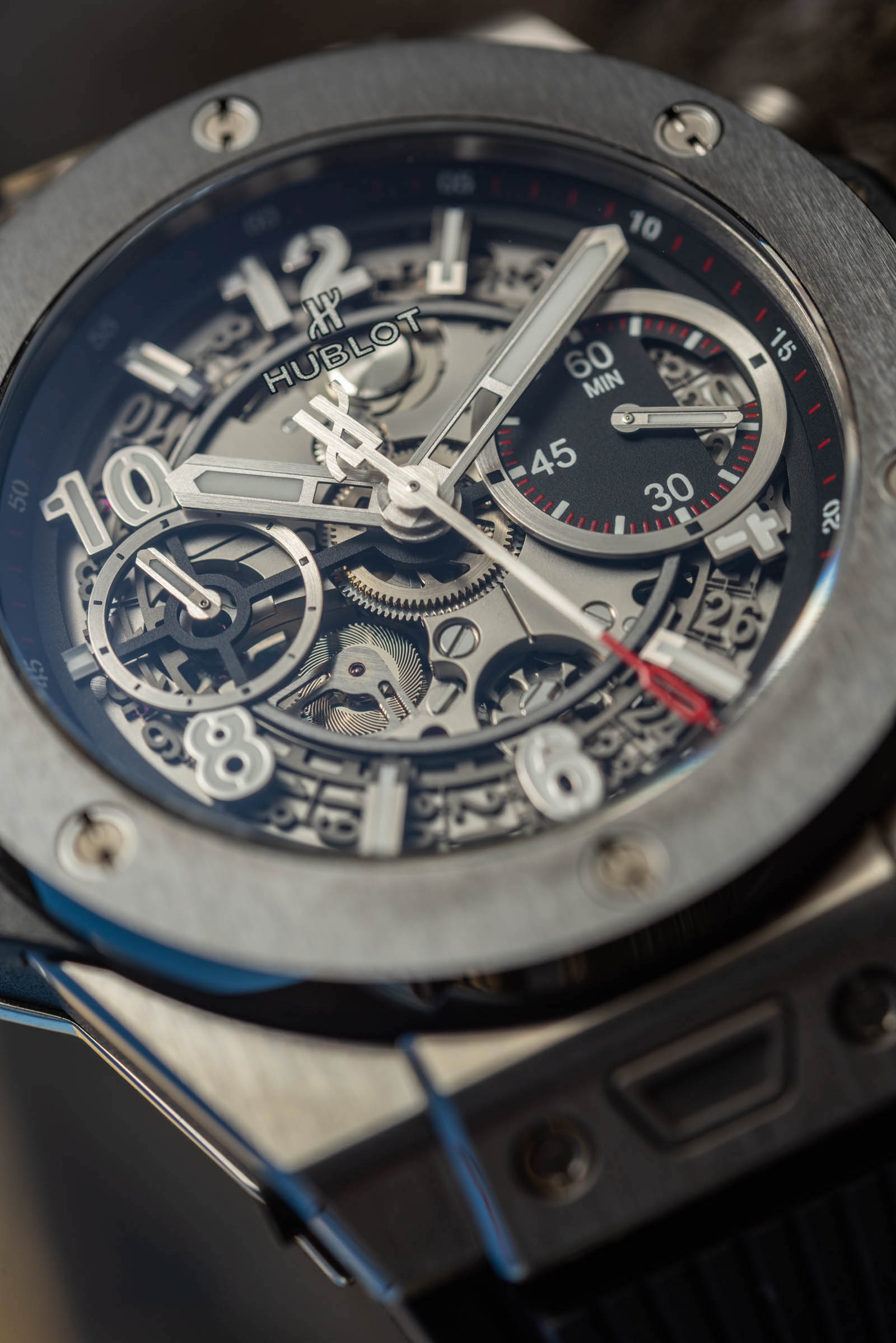
The flexible teeth comes into play because, as I said, this wheel is rotating all the time. By contrast, when the chronograph is stopped, the aforementioned wheel attached to the chronograph seconds hand is, of course, stationary. Now, when you press a rotating wheel against a stationary wheel with both wheels having ordinary teeth profiles, what can happen is a visible and unsightly jitter when the two wheels are pressed against each other in a way that their two pointy ends meet, as opposed to a more fortunate and perfect mesh. These flexible teeth eliminate that jitter and make for a smoother action on the chronograph seconds.
Does this make any real difference? Well, it makes exactly as much difference as any nuanced development in high-end watchmaking: It’s a validator of the manufacture status of a brand, a validating factor of the watch, and the price point. And that’s where its importance ends. The fact that Rolex and Hublot embraced the manufacturing technology required to produce such a wheel — and faced the challenge of implementing it in their pre-existing chronograph movements — set them apart from the rest, at least in this matter. I am not exactly sure how such a remarkably fine, complex, and small wheel is produced, but UV-LiGA fabrication technology springs to mind.
Anyway, the fact that one can nerd out to such extent over a Hublot, I think, speaks volumes not just about Hublot, but the performance (or lack thereof) of the rest of the major luxury watch brands in the sub-$20k segment, as well.
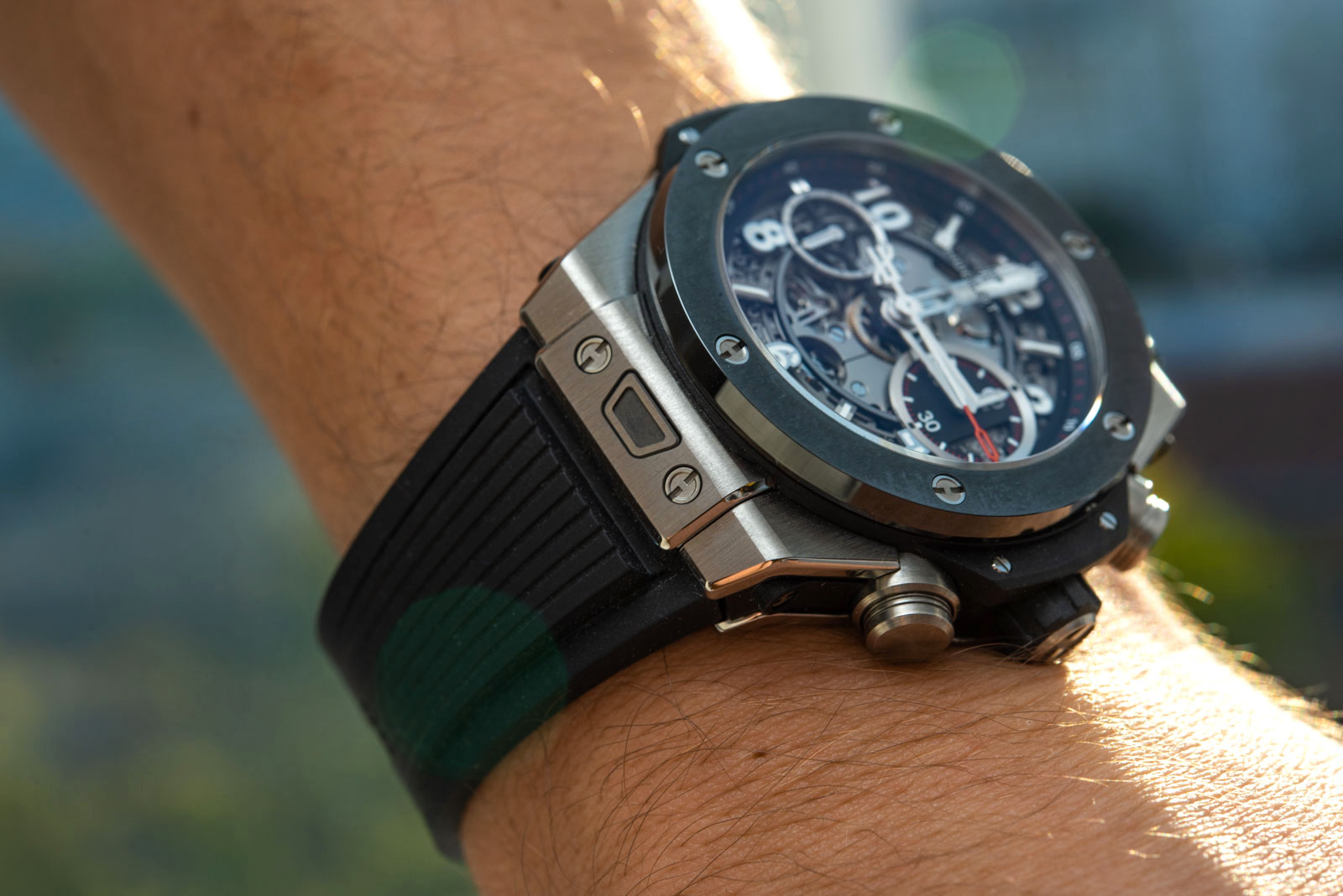
Design & Wearability
Moving on to more relatable and tangible aspects such as design and wearability, the Hublot Big Bang Unico Titanium Ceramic 42mm is not without issues, especially in the latter department. Let’s start with the looks, though.
Love it or hate it, I reckon the Big Bang has been around long enough to mature into itself and step beyond the status of another porthole-wannabe. Again, there are two ways to look at the Big Bang Unico: the hardcore watch nerd’s way and the perception of everyone else who’s outside that group. Not that it’s representative in any way, but it sure is interesting that everyone I’ve shown this watch to loved the way it looked. Men, women, kids, grandparents — everyone openly liked it. I doubt the situation would’ve been even remotely similar had I only shown a picture of the watch.
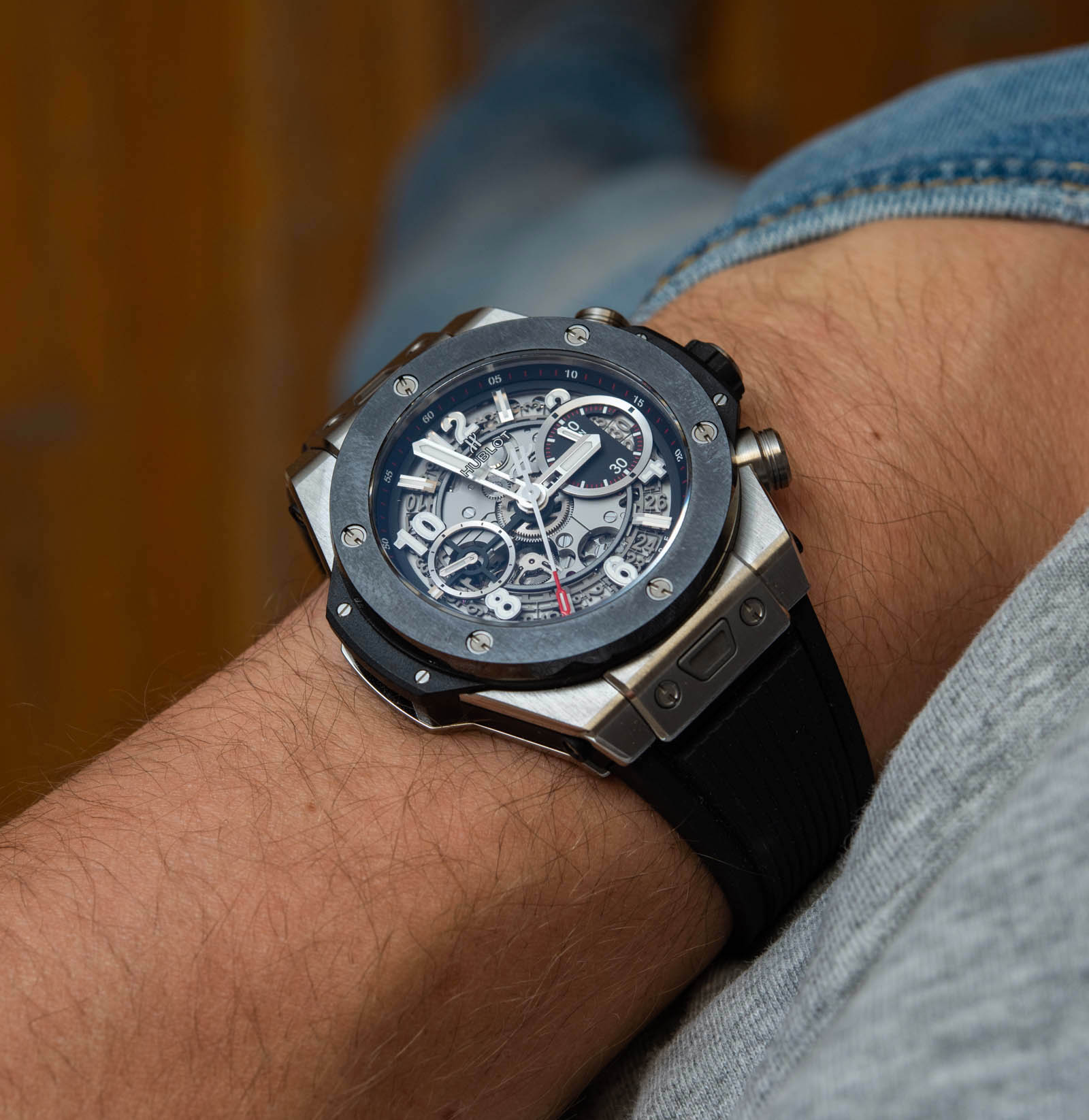
It’s a wearable item that looks high-tech and complex without looking dorky. It looks imposing without (finally) looking compensatory. It looks sophisticated and expensive without looking fragile. I wish I could say this about all the watches I see — the fact that I can’t indicates how challenging it actually is to achieve this balance. It’s difficult because such balance depends on not just sizing, not just the choice of colors, the choice of materials, the angularity and refinement of design elements… but a mishmash of all these things together.
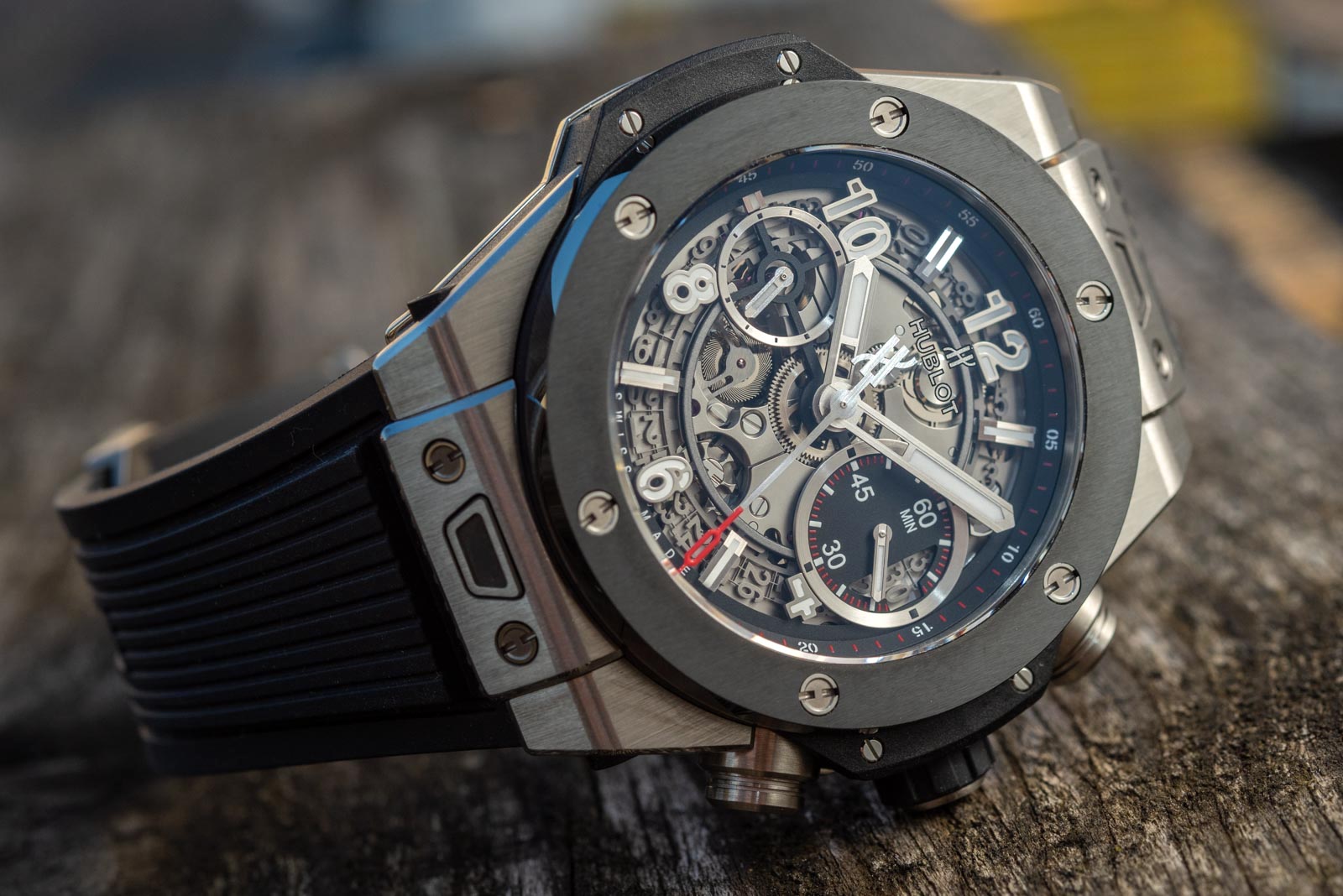
It is interesting to see how the proportions of the 42mm variant has remained exactly the same as that of the larger model. It is extremely difficult to tell the two apart, when judging from the images. That said, the Hublot Big Bang Unico Titanium Ceramic 42mm is a lot larger than the 42mm figure in its name would lead you to believe. The only way this watch measures 42mm is from the 10 o’clock position of the case profile to the edge of the bezel (!) at 4 o’clock.
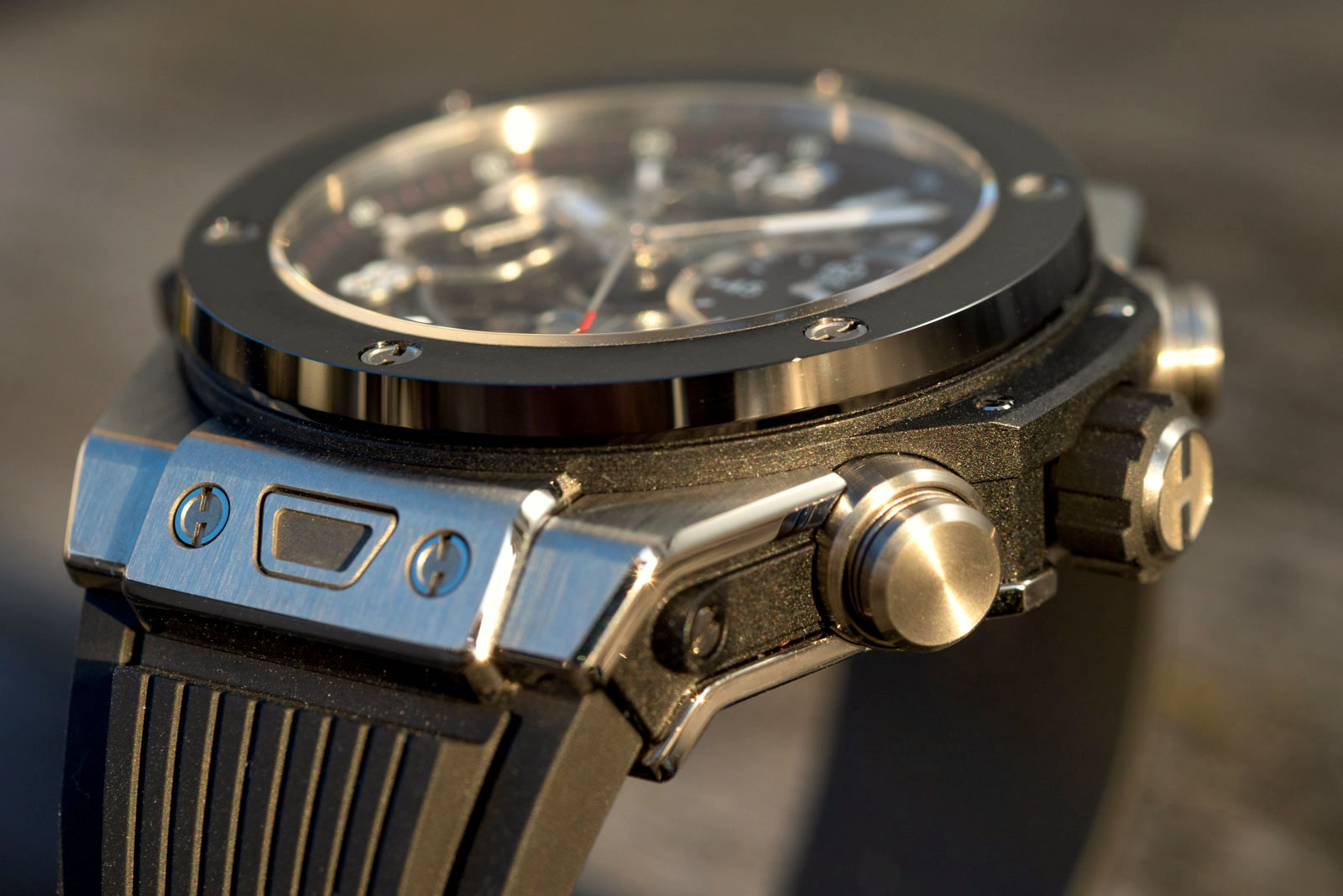
At 4 o’clock, the pusher enters the case at a point where the polished titanium case profile just stops. Sure, there is a ring around the pusher, but that, in Hublot’s mind, doesn’t count. So yeah, this watch does measure 42mm from 10 o’clock to the edge of the bezel at 4 (and obviously from 8 to 2 o’clock all the same). But that’s it.
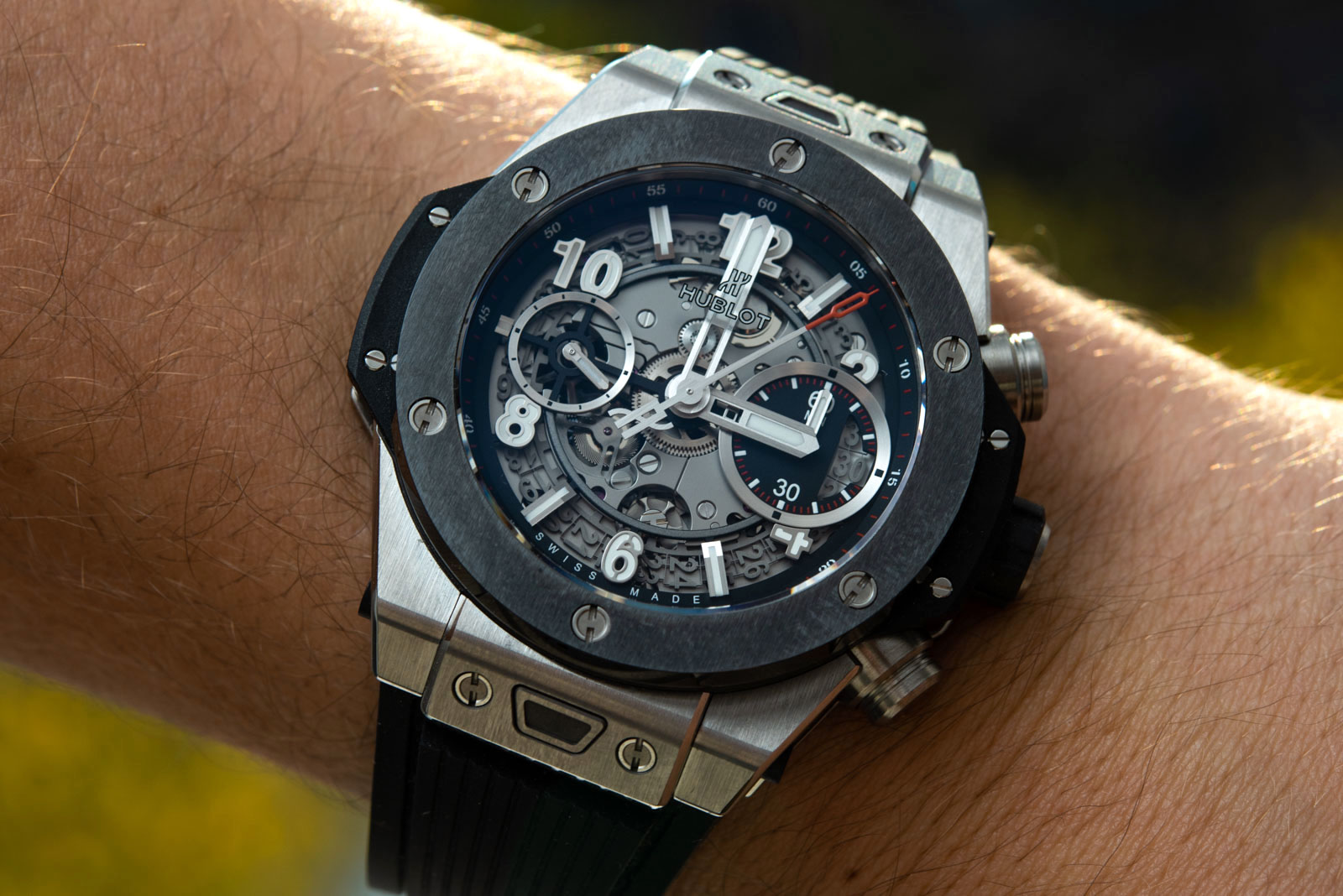
Lug-to-lug, the case measures 52mm, which is at the very top end of lug-to-lug measurements among 42mm watches — they normally rank between 48mm and 50mm, at most. Then, there is the issue of the integration of the strap and their shape. They extend far and away from the case and never exactly downward, adding very substantially to the lug-to-lug visual heft of the watch. It creates the impression of a tall and narrow watch that doesn’t yet look disproportionate, but it’s damn close to being just that.
The overall on-the-wrist visual impression is that of a bold watch that overpowers with its visual clues and design elements — but, at last, not its size. The fact that Hublot has gone through the trouble of shaving 1.3mm off of the movement to make for a slimmer case that looked more proportionate with the narrower diameter deserves huge praise. It has also paid dividends in the look and feel of the watch. It is thick but not a burger — like, say, 7750-equipped sub-40mm chronographs that are just ridiculously thick.
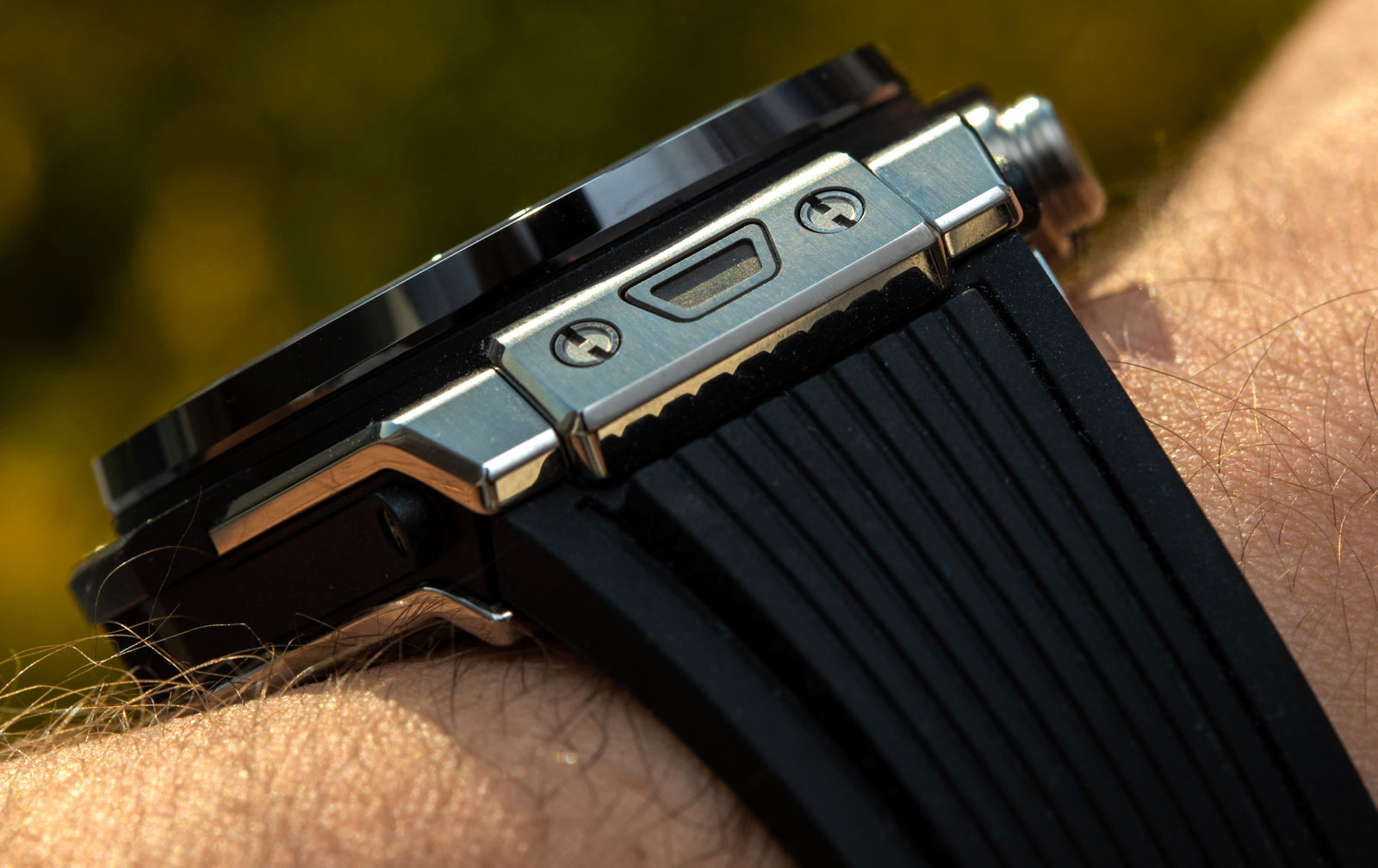
The only truly thick (or, rather, tall) component is the black ceramic bezel that stands proud and tall on its titanium base. It adds depth at the best possible place: It creates the impression of looking into a weird capsule of fine mechanics. You can see the pinions holding the central hands, the large, applied indices adding further depth, as does the Hublot logo printed on the inside of the sapphire crystal. The crystal is ever-so-slightly raised from the plane of the flat bezel, but other than a bevelled edge that’s a fraction of a millimeter tall, the crystal is also perfectly flat.
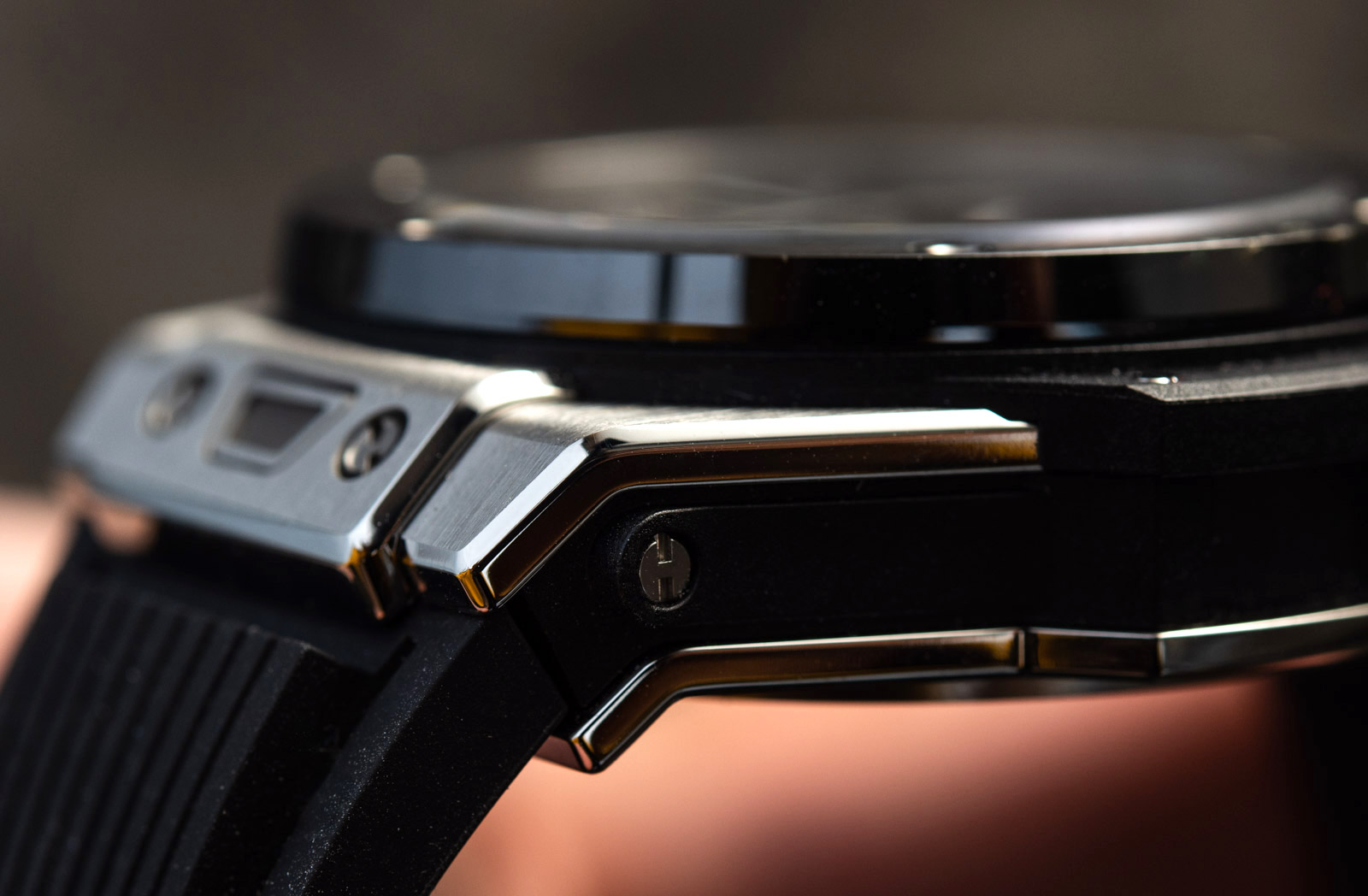
A distinct area in which the Hublot Big Bang Unico Titanium Ceramic 42mm justifies its price is the finishing of its case. Titanium, if less intricately finished, has the tendency to look like a sack of potatoes — it isn’t an inherently beautiful material. Polished edges define the lugs and case profile, while the top surfaces of the lugs are polished. Every angle, surface, and connection between components is absolutely beautifully done. Hublot truly has perfected its triple-layer Big Bang case by now.
The aforementioned black ceramic bezel has a satin top surface and an extremely shiny side profile. It gives a certain peace of mind to know that it forever will be exactly like this — no fading and no scratching (unless you attack it with a diamond). The fragility of ceramic I have discussed before at great length, so there’s no point in repeating just a part of it. Well, what I will say is that I accidentally hit a full-ceramic watch against a lamp post really very hard (the sound it made still wakes me up at night), and it came away unscathed. Read that story, and more on ceramic, here.
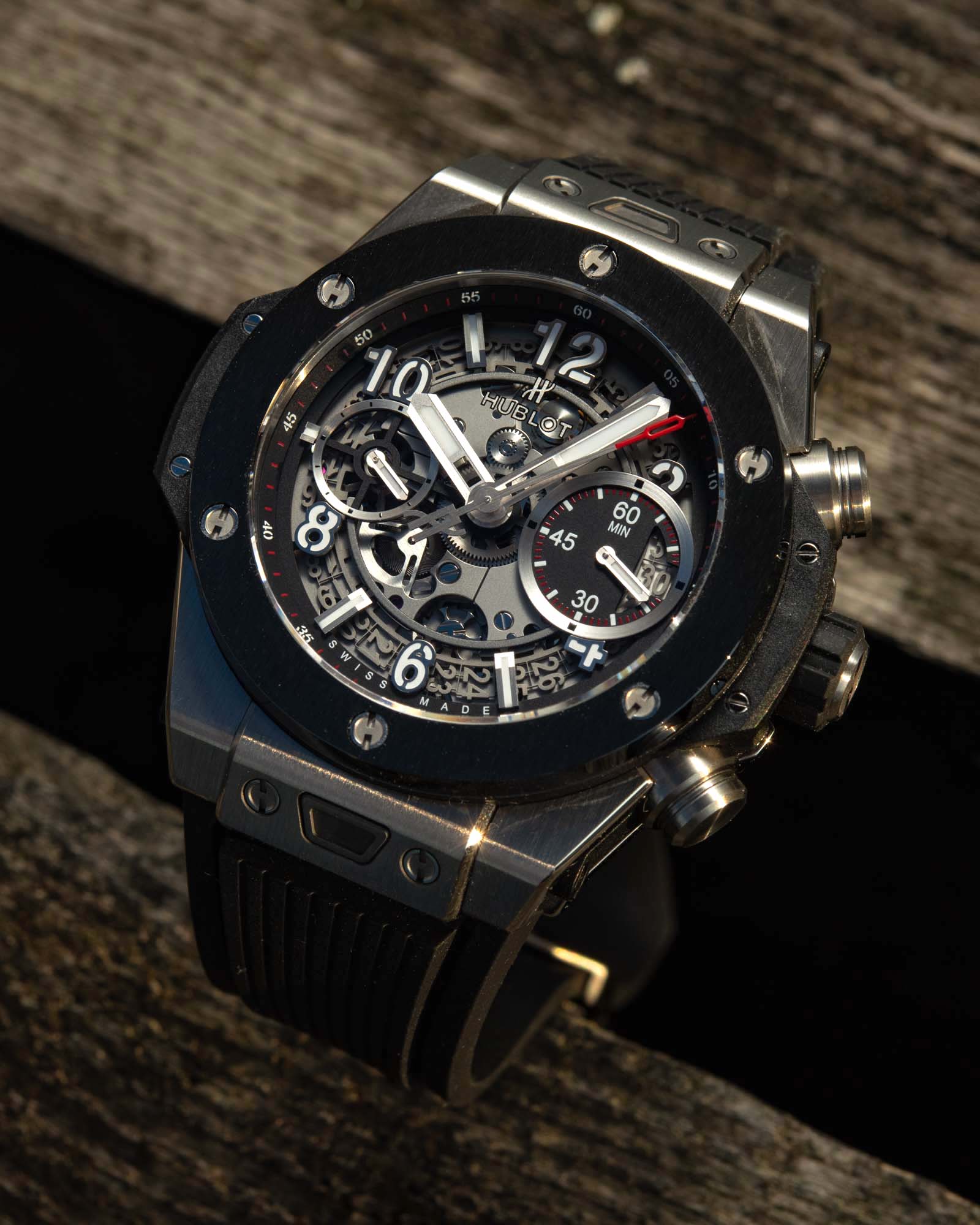
The screws in the bezel are all strangely pointing upward. What’s more, the rest of the screws, when on the same component (case profile, lug structure), are all lined up with one another, too. I’d say maybe all that is by chance, but I seriously doubt it — they appear to have been aligned in the quirky way Hublot likes. Maybe the person putting it together had a bit of an OCD moment and wanted to line these up a bit more than the totally random arrangement the brand is known for. I know the misaligned screws annoy some to no end, but the fact of the matter is that, for just about everyone, they really, truly aren’t noticeable when wearing the watch.
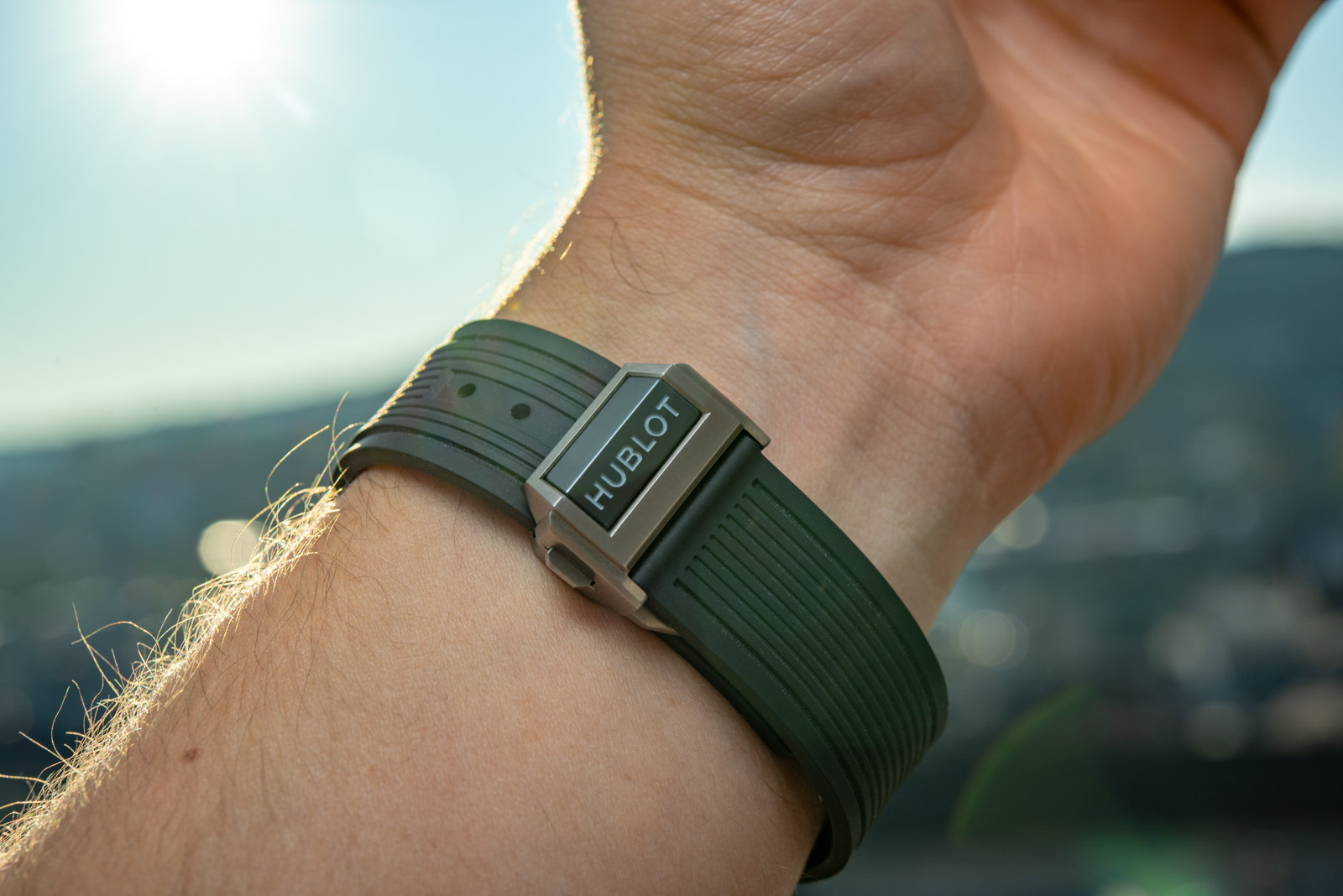
Now, onto the wearability side of things and with that, to something that objectively is annoying. Equipped with the rubber strap, the Hublot Big Bang Unico Titanium Ceramic 42mm is a watch for those who either like to wear their watches rather loose, or have a pancake-shaped wrist.
With the folding clasp closed, the space that the closed strap creates is a whole lot longer than it is tall, which means that you’d have to have a very wide and very flat wrist — not a common thing among us humans, to say the least. So, you either set the straps up in a way that they wrap around the sides of your wrist perfectly and end up with a very-very deep imprint of the metal folding clasp on the underside of your wrist…

… or you end up with a not-so-deep imprint of the clasp and have substantial empty spaces around the strap by the outer edges of your wrist. It is a very poor design that makes for a distinctly uncomfortable wearing experience. You just feel the metal clasp pinching your skin, and when the watch is removed, you see the mark it has left through pressing against the underside of your wrist rather strongly. Needless to say, I ended up wearing the Unico 42mm a bit more loosely around my wrist, and managed to find a non-excruciating compromise. But there is a lot of room for improvement when it comes to the rigid, curved shape the rubber straps are molded into.
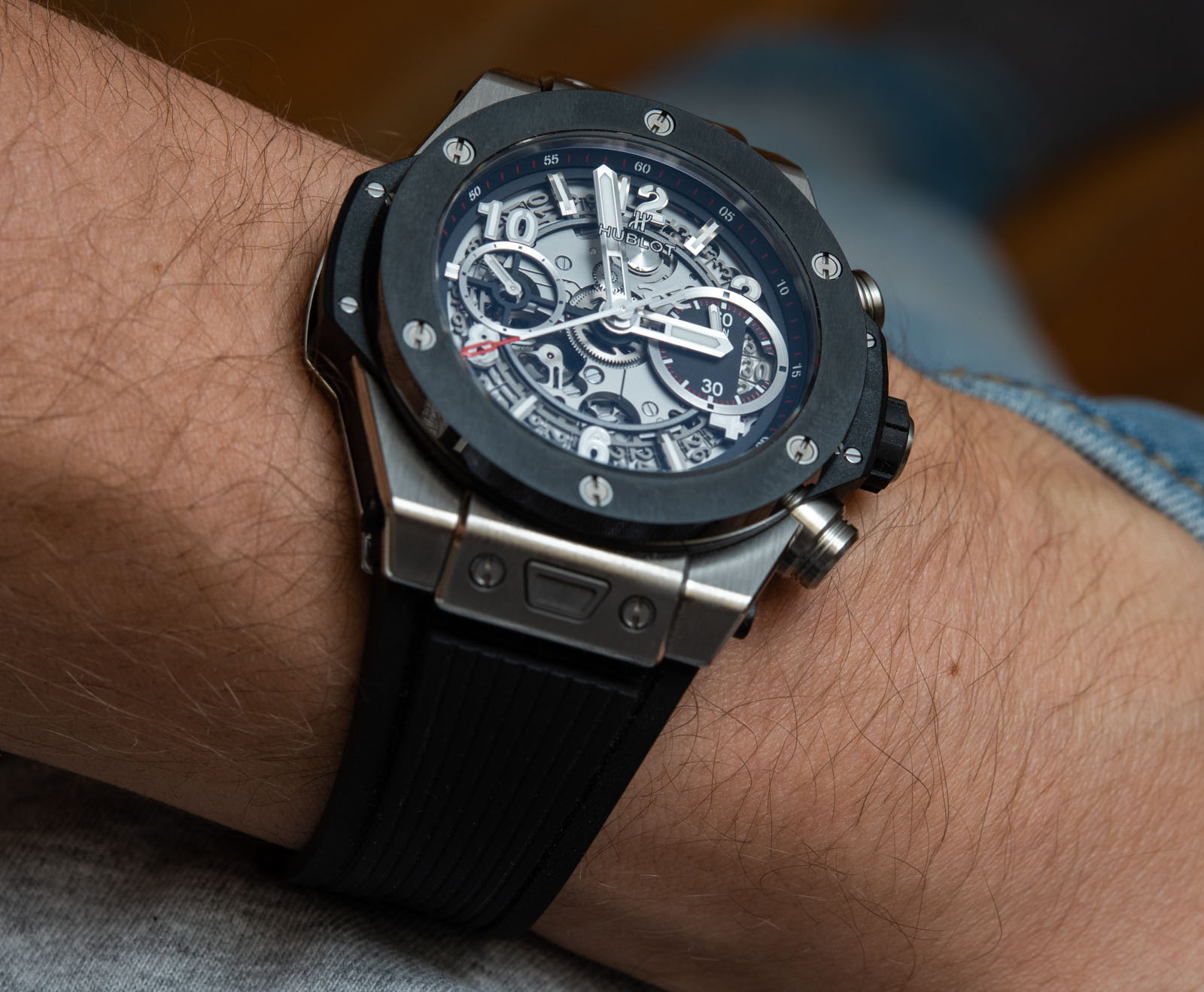
As impressive as the titanium and ceramic case and the Unico movement are, the rubber strap is a let-down in comparison. Although it is thick, and the long lines molded into its surfaces are accurately done, it just doesn’t feel nice enough on a five-figure watch (let alone one that retails in the vicinity of $20,000). A contrasting stitching along the edges, a softer feeling base material, and a more ergonomic overall shape would make for drastic improvements. I can’t stand rubber straps that smell like vanilla — they are just gross — and although Hublot’s straps just have a suppressed rubber strap without any added scent, there is just a bit too much of a smell to them. Again, not exactly luxurious.
It is important to note that, to Hublot’s credit, I haven’t had quite so much of an issue with the leather straps (although those are rubber-backed too) because they followed the shape of my wrist more closely, and didn’t smell off rubber, either. Furthermore, the Unico 42mm case features Hublot’s One-Click system that makes for hassle-free changing of the straps. It also limits you to only using Hublot’s straps — but there is a lot of variety to choose from. Frankly, I’d leave the black rubber strap at the AD and ask for a proper leather strap to go on the watch. It would also make the Hublot Big Bang Unico Titanium Ceramic 42mm look that much more expensive — not that it needs it.
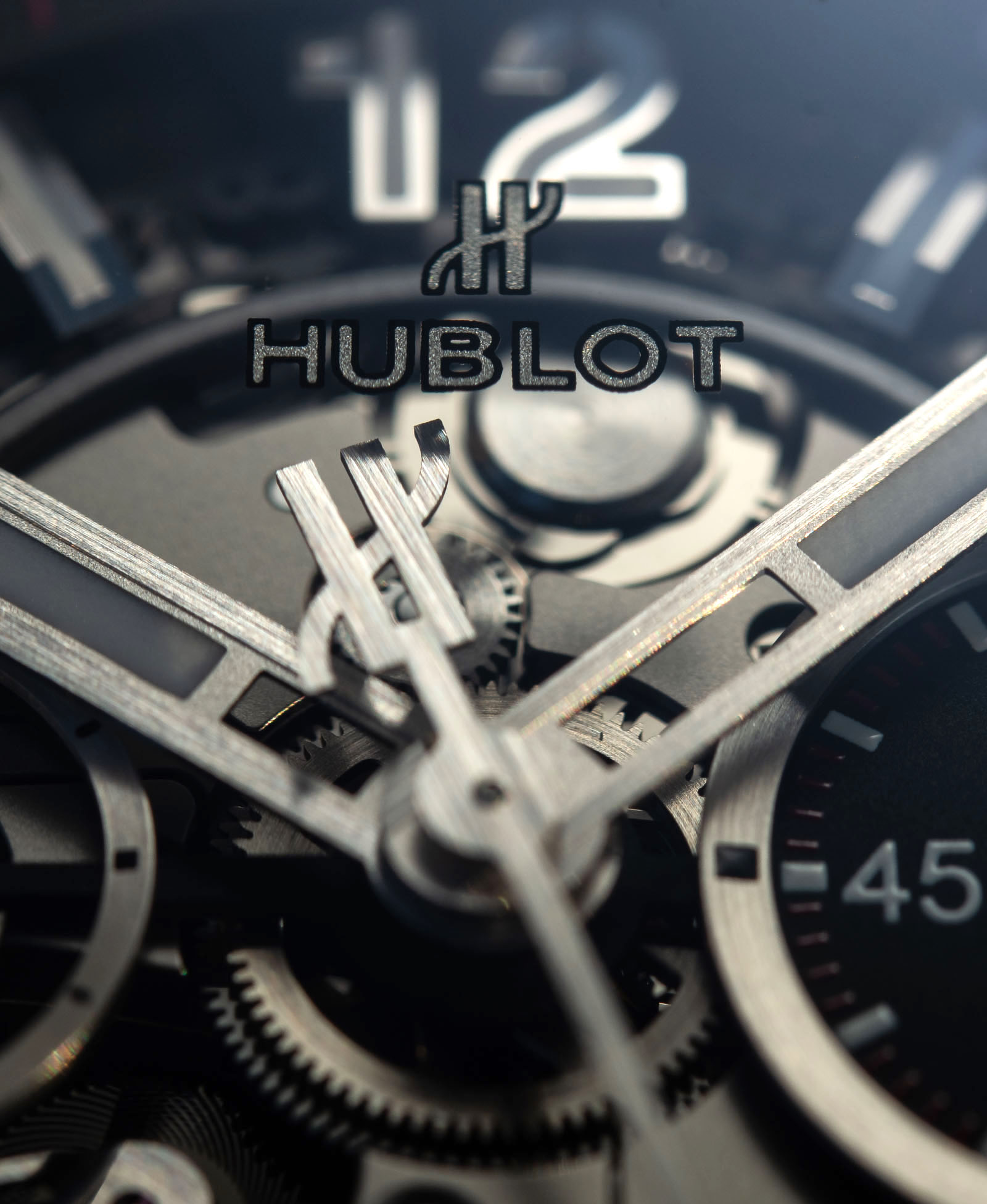
How The Hublot Big Bang Unico 42mm Fits Into The Larger Picture
Add up all that about design, materials and engineering, and you’ll see why I think the Big Bang is its own thing now that no longer is a watch that could be labeled as a me-too wannabe. For one, it is universally recognized as a Hublot. People (again, non-watch people with just a superficial knowledge of luxury items, in general) will recognize it as a Hublot, and those with at least a bit of an interest in watches will all know that it’s a Big Bang. Gone are the days when there’s room for confusion, and Hublot has worked very, very hard to achieve that.
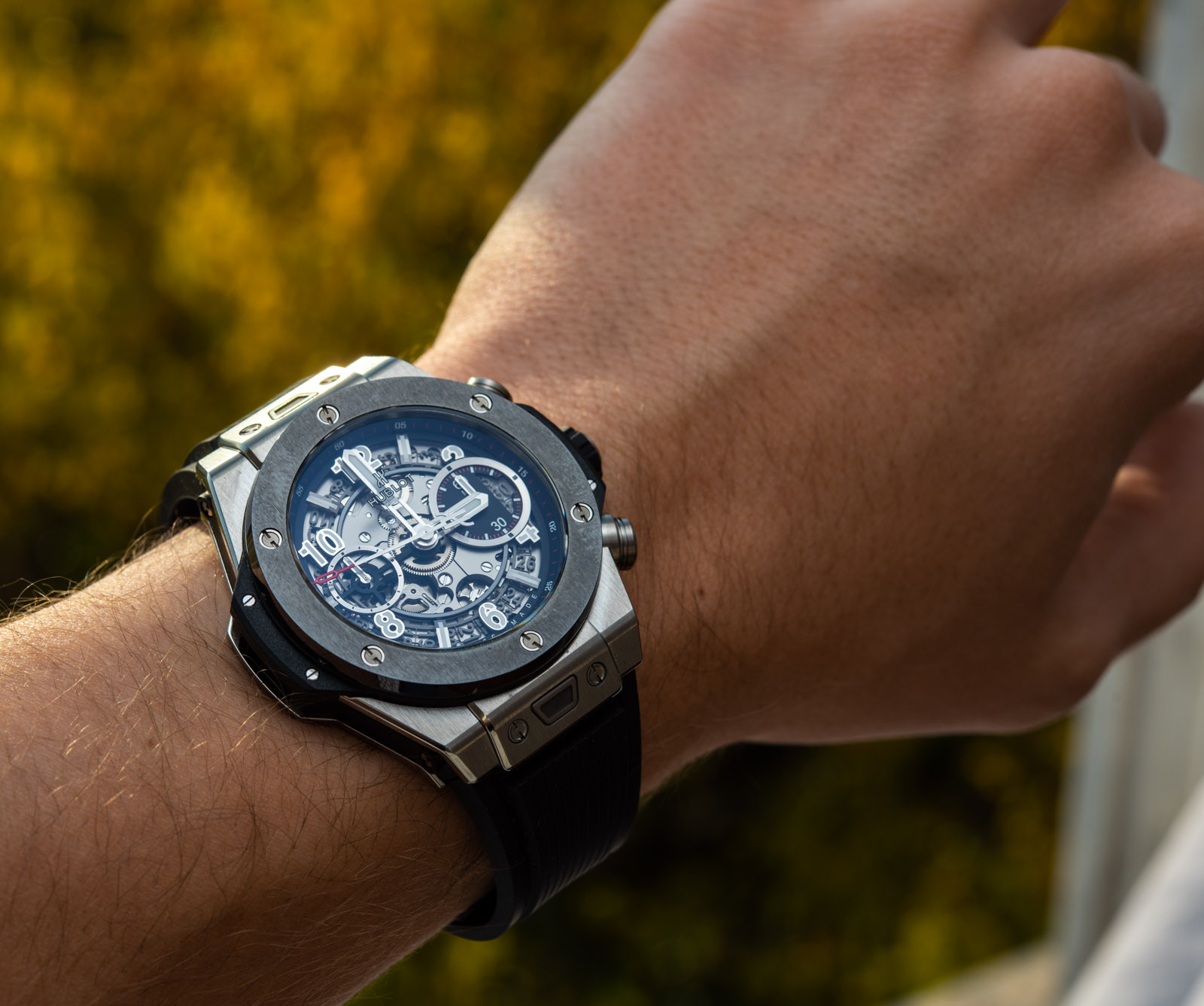
By contrast, Audemars Piguet has become a victim of its own success with the Royal Oak and has failed (rather miserably) to step out of its shadow — although it has vocally and openly been trying for five-plus years now. The ultra-high-end stuff of AP, although impressive, is few and far between, and nowhere near the effect of Hublot’s really crazy stuff. More importantly, the Big Bang outperforms the Royal Oak in the number and versatility of creative designs, use of materials, and any combination of those elements. If I wanted something restrained, would I take a 39mm base Royal Oak over a base Big Bang? Any time of day. But the moment I’d mature (bore) beyond that, I’d want something that is all-around more entertaining. I’d seek those brands that were more successful at creating technically impressive watches that managed to be entertaining at the same time. Watches “brave” enough to replace the “impress-your-peers factor” with the goal of entertaining a watch enthusiast who’s had it with the stuffiness and condescension of brands exactly like AP.
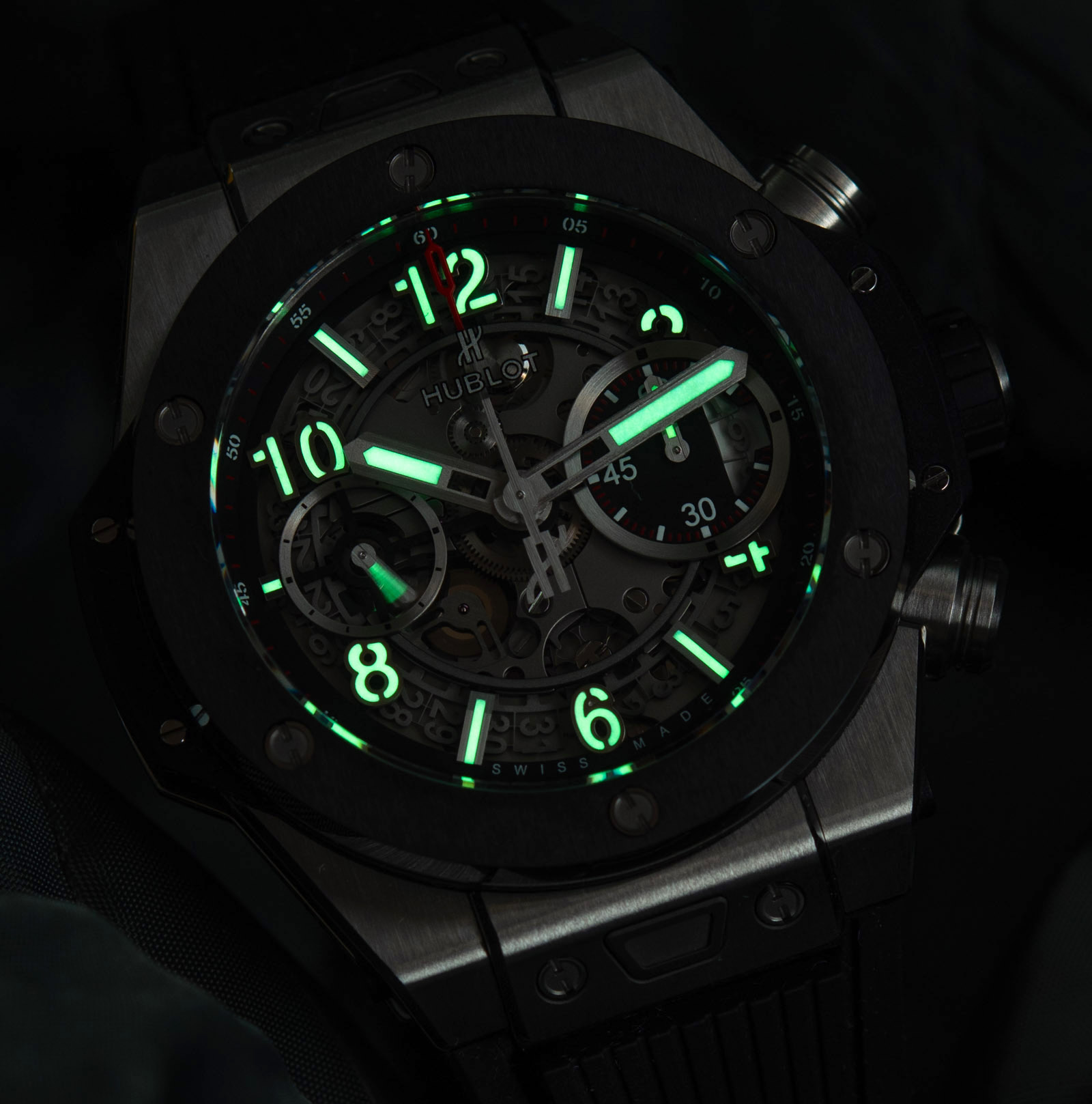
Conclusion
As I said in the beginning, the Hublot Big Bang Unico Titanium Ceramic 42mm is one of many ways that Hublot has for showing the world its horological prowess. The Unico movement is not only a technological marvel, but one that Hublot goes through the trouble of updating and modifying… For what? A 3mm smaller version of the same watch. Now, that’s dedication. The addition of the high-tech, flexible gear is both spectacular and impressive, as is the finishing and quality of execution. Legibility is great, as is the execution and design of the case. Wearability could be a lot better — now that the Unico is such a kick-arse horological achievement, it’s perhaps time to see to updating the rubber straps.
I greatly respect and appreciate Hublot for doing Hublot — without getting sucked into its own past successes, as has happened to so many others in this field. And once you take the time for a closer look at the Hublot Big Bang Unico Titanium Ceramic 42mm, you’ll be greeted by a truly impressive and thoroughly amazing watch that’s a strong contender in its field… Once you are done ticking the boxes of “boring old watches to I need to own to impress others.”
The Hublot Big Bang Unico Titanium Ceramic 42mm is priced at €18,600, a high price justified by a beautifully made case and a deeply impressive movement. You can browse other iterations of the Hublot Big Bang Unico on the brand’s website.
Necessary Data
>Brand: Hublot
>Model: Big Bang Unico Titanium Ceramic 42mm (reference 441.NM.1170.RX)
>Price: €18,600 Euros
>Size: 42mm-wide on paper — wears more like 44mm-45mm watches.
>When reviewer would personally wear it: On a more comfortable strap? Anytime.
>Friend we’d recommend it to first: Seen-it-all watch-lover with the money and the guts to try something new — and be rewarded for it.
>Best characteristic of watch: It finally combines its superb movement and high-tech materials in a more sensible package.
>Worst characteristic of watch: Uncomfortable and poorly fitting rubber strap needs updating.

